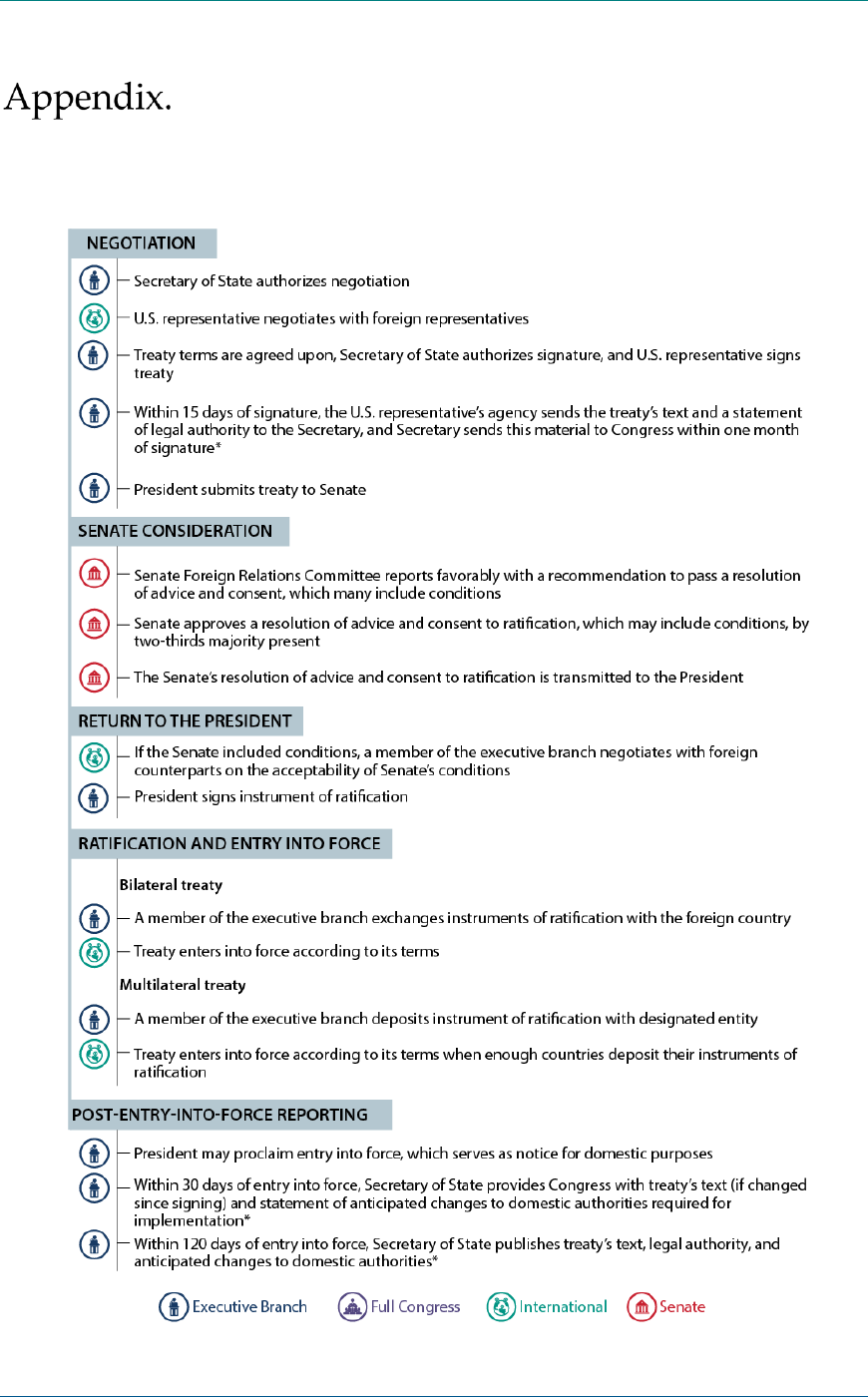
International Law and Agreements:
Their Effect upon U.S. Law
Updated July 13, 2023
Congressional Research Service
https://crsreports.congress.gov
RL32528

International Law and Agreements: Their Effect upon U.S. Law
Congressional Research Service
International Law and Agreements:
Their Effect upon U.S. Law
International law is derived primarily from two sources: international agreements and
customary international practice. Under U.S. law, the United States enters into
international agreements by either executing a treaty or an executive agreement. The
Constitution gives primary responsibility for entering into international agreements to
the executive branch, but Congress plays an essential role in several ways. First, for a
treaty (but not an executive agreement) to become binding upon the United States, the Senate must provide
its advice and consent to ratification by a two-thirds majority. Second, a category of agreements known as
congressional-executive agreements are made by the executive branch with the approval of Congress
through the normal legislative process. Third, many treaties and executive agreements have provisions that
are not self-executing, meaning that Congress must enact implementing legislation to make the provisions
judicially enforceable in the United States.
An international agreement’s status in relation to U.S. law depends on many factors. Self-executing treaties
have a status equal to federal statutes, superior to U.S. state laws and inferior to the Constitution.
Depending on their nature, executive agreements may or may not have a status equal to a federal statute.
Non-self-executing provisions in treaties and executive agreements occupy a complex place in the U.S.
legal system. While non-self-executing provisions bind the United States as a matter of international law,
they do not create rights or obligations enforceable as domestic law in U.S. courts.
Along with legally binding agreements, the executive branch regularly enters into non-binding instruments
with foreign entities. The formality, specificity, and duration of these instruments may vary considerably,
but non-binding instruments do not modify existing legal authorities, which remain controlling under both
U.S. domestic and international law. While they do not create new legal obligations, non-binding
instruments may still carry significant moral and political incentives for compliance.
The second major source of international law is customary international practice. While its effects upon
domestic law are more difficult to discern, more than a century ago the Supreme Court observed that
customary international law is “part of” U.S. law, notwithstanding domestic statutes that conflict with
customary international rules. Scholars have debated whether the Supreme Court’s customary international
law jurisprudence still applies in the modern era. In addition, some domestic U.S. statutes directly
incorporate customary international law and therefore invite courts to interpret and apply this body of law
in the domestic legal system. The Alien Tort Statute serves as one example, as it establishes federal court
jurisdiction over tort claims brought by aliens for violating “the law of nations.” Because the legislative
branch possesses important powers to shape and define the United States’ international obligations,
Congress is likely to continue to play a critical role in shaping international law’s status in the U.S. legal
system.
RL32528
July 13, 2023
Stephen P. Mulligan
Legislative Attorney

International Law and Agreements: Their Effect upon U.S. Law
Congressional Research Service
Contents
Forms of International Commitments ............................................................................................. 5
Treaties ...................................................................................................................................... 6
Executive Agreements ............................................................................................................... 8
Types of Executive Agreements .......................................................................................... 8
Mixed Sources of Authority for Executive Agreements .................................................... 11
Choosing Between a Treaty and an Executive Agreement ............................................... 12
Non-Binding Instruments ........................................................................................................ 15
Transparency Requirements .................................................................................................... 16
Qualifying Non-Binding Instruments ............................................................................... 17
Congressional Reporting and Publication Requirements .................................................. 18
Other Oversight and Transparency Provisions .................................................................. 19
Effects of International Agreements on U.S. Law ......................................................................... 20
Self-Executing vs. Non-Self-Executing Agreements .............................................................. 20
Congressional Implementation of International Agreements .................................................. 22
Conflict with Existing Laws .................................................................................................... 24
Interpreting International Agreements ........................................................................................... 26
Withdrawal from International Agreements .................................................................................. 27
Withdrawal from Executive Agreements and Political Commitments .................................... 28
Withdrawal from Treaties ........................................................................................................ 30
Customary International Law ........................................................................................................ 33
Relationship Between Customary International Law and Domestic Law............................... 34
Statutory Incorporation of Customary International Law and the Alien Tort Statute ............. 36
Conclusion ..................................................................................................................................... 37
Figures
Figure A-1: Steps in Making a Treaty ........................................................................................... 39
Figure A-2: Steps in Making an Executive Agreement ................................................................. 40
Appendixes
Steps in Making a Treaty or Executive Agreement ..................................................... 39
Contacts
Author Information ........................................................................................................................ 41

International Law and Agreements: Their Effect upon U.S. Law
Congressional Research Service 4
nternational law consists of “rules and principles of general application dealing with the
conduct of states and of international organizations and with their relations inter se, as well as
with some of their relations with persons, whether natural or juridical.”
1
While U.S. courts
and officials have long recognized that international law can create legally binding rights and
obligations for the United States, international law’s exact role in the U.S. legal system implicates
complex legal dynamics.
2
The United States takes on new international obligations most often through treaties and other
international agreements.
3
The Constitution vests the power to make treaties in the President, “by
and with the advice and consent of the Senate,”
4
but the United States does not make most
international commitments
5
through this constitutionally defined process. The President regularly
concludes executive agreements and non-binding instruments, which are not mentioned in the
Constitution and are not submitted to the Senate for advice and consent.
6
These international
commitments’ effect on U.S. law depends on what form the commitment takes and whether the
commitment requires implementing legislation from Congress to be judicially enforceable.
7
The United States is also bound by customary international law, which is derived from countries’
general and consistent practice arising out of a sense of legal obligation.
8
In a 1900 opinion, the
Supreme Court described customary international law as “part of our law,”
9
but scholars debate
whether 20th-century legal developments fundamentally altered customary international law’s
role in the U.S. legal system.
10
This report introduces the primary forms of international law and examines their effect on U.S.
law. It also highlights issues that may be particularly relevant to Congress, including the Senate’s
advice and consent function, Congress’s role in interpreting and implementing international
agreements, and the executive branch’s obligations to consult with and report to Congress about
international commitments.
1
RESTATEMENT (THIRD) OF FOREIGN RELATIONS LAW OF THE UNITED STATES § 101 (AM. L. INST. 1987) [hereinafter
THIRD RESTATEMENT]. Although originally limited to nation-to-nation relations, international law grew in the 20th
century with the fields of human rights law and international criminal law to regulate individuals’ conduct in some
circumstances. See, e.g., G.A. Res. 217 (III) (Dec. 10, 1948); Geneva Convention Relative to the Treatment of
Prisoners of War, Aug. 12, 1949, 6 U.S.T. 3316, 75 U.N.T.S. 135; Geneva Convention Relative to the Protection of
Civilian Persons in Time of War, Aug. 12, 1949, 6 U.S.T. 3516, 75 U.N.T.S. 287; G.A. Res. 2200A (XXI) (Dec. 16,
1966; U.N. GAOR, 21st Sess., 1496th plen. mtg., U.N. Doc. A/RES/2200A (XXI) (Dec. 16, 1966).
2
See, e.g., Ware v. Hylton, 3 U.S. (3 Dall.) 199, 281 (1796) (“When the United States declared their independence,
they were bound to receive the law of nations, in its modern state of purity and refinement.”); Chisholm v. Georgia,
2 U.S. (2 Dall.) 419, 474 (1793) (“[T]he United States had, by taking a place among the nations of the earth, become
amenable to the law of nations.”); Letter from Thomas Jefferson, Sec’y of State, to Edmond Charles Genet, French
Minister (June 5, 1793), in JEFFERSON PAPERS, https://founders.archives.gov/documents/Jefferson/01-26-02-0189
(describing the law of nations as an “integral part” of domestic law).
3
See infra “Forms of International Commitments.”
4
U.S. CONST. art. II, § 2, cl. 2.
5
As used in this report, the term commitment is a generic term intended to encompass all forms of legally binding
agreements and non-binding instruments.
6
See infra “Forms of International Commitments.”
7
See infra “Effects of International Agreements on U.S. Law.”
8
See, e.g., THIRD RESTATEMENT, supra note 1, § 102(2).
9
The Paquete Habana, 175 U.S. 677, 700 (1900).
10
See infra “Relationship Between Customary International Law and Domestic Law.”
I

International Law and Agreements: Their Effect upon U.S. Law
Congressional Research Service 5
Forms of International Commitments
For purposes of U.S. law and practice, international commitments between the United States and
foreign nations may take the form of treaties, executive agreements, or non-binding instruments.
11
When using these terms, there are important distinctions between international legal parlance and
domestic American usage. International agreement is a blanket term used to refer to any
agreement between the United States and a foreign state or body that is binding under
international law.
12
In international law, treaty and international agreement are synonymous terms
that refer to any binding agreement.
13
In the context of domestic law, treaty generally refers to a
narrower subcategory of binding international agreements that receives the Senate’s advice and
consent.
14
This report follows the domestic usage unless otherwise noted.
11
For further detail of various types of international commitments and their relationship with U.S. law, see CONG.
RSCH. SERV., 106TH CONG., REP. ON TREATIES AND OTHER INTERNATIONAL AGREEMENTS: THE ROLE OF THE UNITED
STATES SENATE 43–97 (Comm. Print 2001) [hereinafter TREATIES AND OTHER INTERNATIONAL AGREEMENTS], available
at https://www.govinfo.gov/content/pkg/CPRT-106SPRT66922/pdf/CPRT-106SPRT66922.pdf; Curtis A. Bradley &
Jack L. Goldsmith, Presidential Control Over International Law, 131 HARV. L. REV. 1201, 1207–09 (2018).
12
RESTATEMENT (FOURTH) OF THE FOREIGN RELATIONS LAW OF THE UNITED STATES § 301 cmt. a (AM. L. INST. 2018)
[hereinafter FOURTH RESTATEMENT]. See also James M. Inhofe National Defense Authorization Act for Fiscal Year
2023, Pub. L. No. 117-263, 136 Stat. 2395, 2600 (2022) (to be codified in 1 U.S.C. § 112b(k)(4)(A)) [hereinafter 2023
NDAA].
13
See Vienna Convention on the Law of Treaties art. 2, Apr. 24, 1970, 1155 U.N.T.S. 331 [hereinafter Vienna
Convention]. Although the United States has not ratified the Vienna Convention, courts and the executive branch
generally regard it as reflecting customary international law on many matters. See, e.g., De Los Santos Mora v. New
York, 524 F.3d 183, 196 n.19 (2d Cir. 2008) (“Although the United States has not ratified the Vienna Convention on
the Law of Treaties, our Court relies upon it ‘as an authoritative guide to the customary international law of treaties,’
insofar as it reflects actual state practices.”) (quoting Avero Belg. Ins. v. Am. Airlines, Inc., 423 F.3d 73, 80 n.8 (2d
Cir. 2005)); Fujitsu Ltd. v. Fed. Express Corp., 247 F.3d 423, 433 (2d Cir. 2001) (“[W]e rely upon the Vienna
Convention here as an ‘authoritative guide to the customary international law of treaties.’ ”) (quoting Chubb & Son,
Inc. v. Asiana Airlines, 214 F.3d 301, 309 (2d Cir. 2000)). But see THIRD RESTATEMENT, supra note 1, § 208 reporters’
n.4 (“[T]he [Vienna] Convention has not been ratified by the United States and, while purporting to be a codification of
preexisting customary law, it is not in all respects in accord with the understanding and the practice of the United States
and of some other states.”); The Administration’s Proposal for a U.N. Resolution on the Comprehensive Nuclear Test-
Ban Treaty: Hearing Before the Sen. Comm. on Foreign Relations, 114th Cong. (2016) (statement of Stephen G.
Rademaker, Principal, The Podesta Grp.), https://www.foreign.senate.gov/download/090716_rademaker_testimony
[hereinafter Rademaker Statement] (“[T]he more correct statement with respect to the Vienna Convention would be
that in the opinion of the Executive branch it generally reflects customary international law, but, in the opinion of the
Senate, in important respects it does not.”).
14
See, e.g., 2023 NDAA, 136 Stat. 2600 (codified in 1 U.S.C. § 112b(k)(4)(A)); FOURTH RESTATEMENT, supra note 12,
§ 301 cmt. a. Under U.S. law, the term treaty is not always interpreted to refer only to those agreements described in
Article II, Section 2, of the Constitution. See Weinberger v. Rossi, 456 U.S. 25, 31–32 (1982) (interpreting statute
barring discrimination except where permitted by “treaty” to refer to both treaties and executive agreements);
B. Altman & Co. v. United States, 224 U.S. 583, 601 (1912) (construing the term treaty, as used in statute conferring
appellate jurisdiction, to also refer to executive agreements).

International Law and Agreements: Their Effect upon U.S. Law
Congressional Research Service 6
Forms of International Commitments
International agreement: A blanket term used to refer to any agreement between the United States and a
foreign state or body that is binding under international law.
15
Treaty: An international agreement that receives the advice and consent of the Senate and is ratified by the
President through the process defined in the Treaty Clause.
16
Executive agreement: An international agreement that is binding but which the President enters into without
receiving the advice and consent of the Senate.
17
Non-binding instrument: An instrument between the United States and a foreign entity that is not binding
under international law but may carry non-legal incentives for compliance.
18
Treaties
Under U.S. law, a treaty is an agreement negotiated and signed by a member of the executive
branch that enters into force if approved by a two-thirds majority of the Senate and ratified by the
President.
19
Most modern treaties require parties to exchange or deposit instruments of ratification
to enter into force.
20
A chart depicting the steps necessary for the United States to enter into a
treaty is in the Appendix.
The Treaty Clause—Article II, Section 2, clause 2, of the Constitution—vests the power to make
treaties in the President, acting with the “advice and consent” of the Senate.
21
Many scholars have
concluded that the Framers intended “advice” and “consent” to be separate aspects of the treaty-
making process.
22
According to this interpretation, the “advice” element required the President to
consult the Senate during treaty negotiations before seeking the Senate’s final “consent.”
23
Early
in his presidency, President George Washington appears to have followed the process that the
Senate had such a consultative role,
24
but he and other early Presidents soon declined to seek the
15
FOURTH RESTATEMENT, supra note12, § 301 cmt. a. See also 2023 NDAA, 136 Stat. 2600 (codified in 1 U.S.C.
§ 112b(k)(4))
16
See 2023 NDAA, supra note 14; FOURTH RESTATEMENT, supra note 12, § 301 cmt. a.; Weinberger, 456 U.S. at 31–
32 (1982); B. Altman, 224 U.S. at 601.
17
See infra “Executive Agreements.”
18
See infra Non-Binding Instruments.”
19
See FOURTH RESTATEMENT, supra note 12, § 301 cmt. a.
20
See id. § 304 cmt. a (“Some agreements provide that they are binding upon signature alone, although signature ad
referendum (that is, subject to confirmation through some subsequent act) is frequently employed.”); Curtis A. Bradley,
Unratified Treaties, Domestic Politics and the U.S. Constitution, 48 HARV. INT’L L.J. 307, 313 (2007) (“Under modern
practice ... consent is manifested through a subsequent act of ratification—the deposit of an instrument of ratification or
accession with a treaty depositary in the case of multilateral treaties, and the exchange of instruments of ratification in
the case of bilateral treaties.”).
21
For additional background on the Treaty Clause, see Cong. Research Serv., Treaty Clause: Overview of the
President’s Treaty-Making Power, CONSTITUTION ANNOTATED, https://constitution.congress.gov/browse/essay/artII-S2-
C2-1-1/ALDE_00012952/ (last visited Jan 12, 2023).
22
See, e.g., LOUIS HENKIN, FOREIGN AFFAIRS AND THE U.S. CONSTITUTION 177 (2d ed. 1996); Arthur Bestor, “Advice”
from the Very Beginning, “Consent” When the End Is Achieved, 83 AM. J. INT’L L. 718, 726 (1989).
23
See supra note 22.
24
On the occasion that scholars have described as the first and last time the President personally visited the Senate
chamber to receive the Senate’s advice on a treaty, President Washington went to the Senate in August 1789 to consult
about proposed treaties with the Southern Indians. See 1 ANNALS OF CONG. 65–71 (1789). Observers reported that he
was so frustrated with the experience that he vowed never to appear in person to discuss a treaty again. See, e.g.,
WILLIAM MACLAY, SKETCHES OF DEBATE IN THE FIRST SENATE OF THE UNITED STATES 122–24 (George W. Harris ed.,
1880) (record of the President’s visit by Senator William Maclay of Pennsylvania); RALSTON HAYDEN, THE SENATE
AND TREATIES, 1789–1817, at 21–26 (1920) (providing a historical account of Washington’s visit to the Senate).

International Law and Agreements: Their Effect upon U.S. Law
Congressional Research Service 7
Senate’s input during the negotiation process.
25
In modern treaty-making practice, the executive
branch generally assumes responsibility for negotiations, and the Supreme Court has stated that
the President’s constitutional power to conduct treaty negotiations is exclusive.
26
Although Presidents generally do not consult the Senate during treaty negotiations, the Senate
maintains an aspect of its “advice” function by providing conditional consent.
27
In considering a
treaty, the Senate may condition its consent on proposed conditions known as reservations,
28
understandings,
29
or declarations
30
(RUDs).
31
The Senate has sometimes imposed other
requirements under other labels such as condition
32
or proviso,
33
which often set forth procedural
requirements for ratifying or implementing a treaty.
34
Under established U.S. practice, the
President cannot ratify a treaty unless the President accepts the Senate’s RUDs and other
conditions.
35
If accepted by the President, RUDs and other conditions may modify or define U.S.
25
See MEMOIRS OF JOHN QUINCY ADAMS 427 (Charles Francis Adams ed., 1875) (“[E]ver since [President
Washington’s first visit to the Senate to seek its advice], treaties have been negotiated by the Executive before
submitting them to the consideration of the Senate.”).
26
See Zivotofsky v. Kerry, 576 U.S. 1, 13 (2015) (“The President has the sole power to negotiate treaties.... ”); United
States v. Curtiss-Wright Export Corp., 299 U.S. 304, 319 (1936).
27
Accord Curtis A. Bradley & Jack L. Goldsmith, Treaties, Human Rights, and Conditional Consent, 149 U. PA. L.
REV. 399, 405 (2000) (“The exercise of the conditional consent power has been in part a response by the Senate to its
loss of any substantial ‘advice’ role in the treaty process.”); SAMUEL B. CRANDALL, TREATIES, THEIR MAKING AND
ENFORCEMENT 81 (2d ed. 1916) (“Not usually consulted as to the conduct of negotiations, the Senate has freely
exercised its co-ordinate power in treaty making by means of amendments.”).
28
As a general matter, “[r]eservations change U.S. obligations without necessarily changing the text, and they require
the acceptance of the other party.” See TREATIES AND OTHER INTERNATIONAL AGREEMENTS, supra note 11, at 11.
Accord FOURTH RESTATEMENT, supra note 12, § 305 reporters’ n.2 (“Although the Senate has not been entirely
consistent in its use of the labels, in general the label ... ‘reservation’ [has been used] when seeking to limit the effect of
the existing text for the United States.”).
29
Understandings are “interpretive statements that clarify or elaborate provisions but do not alter them.” TREATIES AND
OTHER INTERNATIONAL AGREEMENTS, supra note 11, at 11. Accord FOURTH RESTATEMENT, supra note 12, § 305
reporters’ n.5.B (“The Senate has regularly used ‘understandings’ to set forth the U.S. interpretation of particular treaty
provisions.”).
30
Declarations are “statements expressing the Senate’s position or opinion on matters relating to issues raised by the
treaty rather than to specific provisions.” TREATIES AND OTHER INTERNATIONAL AGREEMENTS, supra note 11, at 11. See
also FOURTH RESTATEMENT, supra note 12, § 305 reporters’ n.5.E (“The Senate sometimes uses ‘declarations’ to
express views on matters of policy.”).
31
For additional background on RUDs, see CRS In Focus IF12208, Reservations, Understandings, Declarations, and
Other Conditions to Treaties, by Stephen P. Mulligan.
32
See, e.g., Resolution of Advice and Consent to Ratification of Protocols to the North Atlantic Treaty of 1949 on the
Accession of the Republic of Finland and the Kingdom of Sweden § 3, S. TREATY DOC. 117-3, available at
https://www.congress.gov/treaty-document/117th-congress/3/resolution-text (providing advice and consent subject to
the condition that the President make certain certifications to the Senate).
33
See, e.g., Resolution of Advice and Consent to Ratification of the Food Aid Convention 1999 § 3(b), S. TREATY
DOC.106-4, available at https://www.congress.gov/treaty-document/106th-congress/14/resolution-text (providing
advice and consent subject to the provision that “Nothing in the Convention requires or authorizes legislation or other
action by the United States of America that is prohibited by the Constitution of the United States as interpreted by the
United States”).
34
Procedural matters include requirements that the President make certifications to the Senate, produce reports, or
consult certain congressional committees on issues the treaty raises. See TREATIES AND OTHER INTERNATIONAL
AGREEMENTS, supra note 11, at 11; FOURTH RESTATEMENT, supra note 14, § 305 reporters’ n.2.
35
FOURTH RESTATEMENT, supra note 12, § 305 reporters’ n.4. See also United States v. Stuart, 489 U.S. 353, 374–75
(1989) (Scalia, J., concurring) (“[The Senate] may, in the form of a resolution, give its consent on the basis of
conditions. If these are agreed to by the President and accepted by the other contracting parties, they become part of the
treaty and of the law of the United States.... ”).

International Law and Agreements: Their Effect upon U.S. Law
Congressional Research Service 8
rights and obligations under the treaty.
36
The Senate may also propose to amend the text of the
treaty itself, and other nations that are parties to the treaty must consent to the changes for them to
take effect.
37
Executive Agreements
The great majority of international agreements that the United States enters into are not treaties
but executive agreements—agreements entered into by the executive branch that are not
submitted to the Senate for its advice and consent.
38
The Constitution does not specifically
discuss executive agreements, but they have still been considered valid international agreements
under Supreme Court jurisprudence and as a matter of historical practice.
39
The United States has
made executive agreements since the earliest days of the Republic,
40
and their use increased
significantly in the post–World War II era.
41
Commentators estimate that more than 90% of the
United States’ international agreements have been in the form of an executive agreement.
42
Types of Executive Agreements
There are three categories of executive agreements—congressional-executive agreements,
executive agreements made pursuant to a treaty, and sole executive agreements. Executive
agreements are traditionally categorized based upon the source of the President’s authority to
conclude them. In the case of congressional-executive agreements, Congress provides the
President with domestic authority through legislation enacted through the bicameral process.
43
36
For discussion of historical examples of conditions attached by the Senate to treaties, see FOURTH RESTATEMENT,
supra note 12, § 305 reporters’ n.5.
37
For example, in giving its advice and consent to the first treaty that was to be ratified by the United States after the
adoption of the Constitution—dubbed the Jay Treaty because it was negotiated by the first Supreme Court Chief Justice
of the United States, John Jay, who was appointed a special envoy to Great Britain despite his role in the judicial
branch—the Senate insisted on suspending an article allowing Great Britain to restrict U.S. trade in the British West
Indies. S. EXEC. JOURNAL, 4th Cong., Spec. Sess. 186 (1795). Great Britain ratified the Jay Treaty without objection to
the Senate’s changes. See HAYDEN, supra note 24, at 86–88.
38
See infra notes 40–42 (discussing historical usage of executive agreements and related judicial opinions).
39
See, e.g., Am. Ins. Ass’n v. Garamendi, 539 U.S. 396, 415 (2003) (“[O]ur cases have recognized that the President
has authority to make ‘executive agreements’ with other countries, requiring no ratification by the Senate or approval
by Congress, this power having been exercised since the early years of the Republic.”); Dames & Moore v. Regan, 453
U.S. 654, 680 (1981) (recognizing presidential power to settle claims of U.S. nationals and concluding “that Congress
has implicitly approved the practice of claim settlement by executive agreement”); United States v. Belmont, 301 U.S.
324, 330 (1937) (“[A]n international compact ... is not always a treaty which requires the participation of the Senate.”).
40
See, e.g., Garamendi, 539 U.S. at 415 (discussing “executive agreements to settle claims of American nationals
against foreign governments” dating back to “as early as 1799”); Act of Feb. 20, 1792, ch. 8, § 26, 1 Stat. 239 (act
passed by the Second Congress authorizing postal-related executive agreements).
41
See TREATIES AND OTHER INTERNATIONAL AGREEMENTS, supra note 11, at 38; Oona A. Hathaway, Treaties’ End:
The Past, Present, and Future of International Lawmaking in the United States, 117 YALE L.J. 1236, 1288 (2008);
Bradley & Goldsmith, supra note 11, at 1210.
42
Bradley & Goldsmith, supra note 11, at 1213. See also TREATIES AND OTHER INTERNATIONAL AGREEMENTS, supra
11, at 40.
43
Congress sometimes enacts legislation that pre-authorizes the President to conclude executive agreements on certain
subjects or within certain parameters. See, e.g., CLOUD Act, Pub. L. No. 115-141, div. V, § 105, 132 Stat. 1213, 1217
(2018) (codified at 18 U.S.C. § 2523) (authorizing data-sharing executive agreements with certain foreign nations);
Foreign Assistance Act of 1961, Pub. L. No. 87-195, 75 Stat. 424 (codified as amended at 22 U.S.C. §§ 2151–2431k)
(authorizing the President to furnish assistance to foreign nations “on such terms and conditions as he may determine,
to any friendly country”). Pre-authorized agreements are sometimes referred to as ex ante agreements. On other
occasions, Congress enacts legislation approving agreements that the President already negotiated and signed. See, e.g.,
(continued...)

International Law and Agreements: Their Effect upon U.S. Law
Congressional Research Service 9
The President also enters into executive agreements made pursuant to a treaty based on authority
granted to the President in prior Senate-approved, ratified treaties.
44
In other cases, the President
enters into sole executive agreements based on a claim of independent presidential power in the
Constitution.
45
A chart describing the steps in making an executive agreement is in the Appendix.
Categories of Executive Agreements
Congressional-executive agreement: an executive agreement that Congress authorizes through legislation
enacted through the bicameral process.
46
Executive agreement made pursuant to a treaty: an executive agreement based on the President’s
authority in a treaty previously approved by the Senate.
Sole executive agreement: an executive agreement based on the President’s constitutional powers.
Congressional-Executive Agreements
Congressional-executive agreements have long-standing historical precedent dating to the Second
Congress.
47
The Supreme Court has never directly addressed the constitutionality of
congressional-executive agreements, but it has recognized that the United States possesses the
“power to make such international agreements as do not constitute treaties in the constitutional
sense.”
48
The Court has also stated that, while a congressional-executive agreement may lack the
“dignity” of a Senate-approved treaty, it is still a valid international instrument.
49
Whereas only
the Senate gives consent to treaties, both houses of Congress are involved in authorizing
congressional-executive agreements.
50
Historically, congressional-executive agreements have
covered many topics ranging from postal conventions to bilateral trade to military assistance.
51
United States-Mexico-Canada Agreement Implementation Act, Pub. L. No. 116-113, § 101 (2020) (providing
approving for the United States-Mexico-Canada Agreement Implementation Act). Agreements authorized after
conclusion are sometimes referred to as ex post agreements.
44
See THIRD RESTATEMENT, supra note 1, § 303(3); TREATIES AND OTHER INTERNATIONAL AGREEMENTS, supra note 11,
at 86.
45
See TREATIES AND OTHER INTERNATIONAL AGREEMENTS, supra note 11, at 88. See also supra note 39 (citing
Supreme Court case law recognizing the validity of sole executive agreements).
46
For background on methods of legislative approval for congressional-executive agreements, see supra note 43.
47
The Second Congress enacted legislation in 1792 authorizing the postmaster general to “make arrangements with the
postmasters in any foreign country for the reciprocal receipt and delivery of letters and packets, through the post
offices.” Act of Feb. 20, 1792, ch. 8, § 26, 1 Stat. 239.
48
United States v. Curtiss-Wright Export Corp., 299 U.S. 304, 318 (1936).
49
See B. Altman & Co. v. United States, 224 U.S. 583, 601 (1912) (“While it may be true that this commercial
agreement, made under authority of the tariff act of 1897, § 3, was not a treaty possessing the dignity of one requiring
ratification by the Senate of the United States, it was an international compact, negotiated between the representatives
of two sovereign nations, and made in the name and on behalf of the contracting countries, and dealing with important
commercial relations between the two countries, and was proclaimed by the President. If not technically a treaty
requiring ratification, nevertheless it was a compact authorized by the Congress of the United States, negotiated and
proclaimed under the authority of its President.”).
50
Congress authorizes congressional-executive agreements through legislation enacted through the bicameral process,
which involves both houses of Congress. For background on bicameralism, see Cong. Research Serv., Bicameralism,
CONSTITUTION ANNOTATED, https://constitution.congress.gov/browse/essay/artI-S1-3-4/ALDE_00013293// (last visited
June. 21, 2023).
51
See TREATIES AND OTHER INTERNATIONAL AGREEMENTS, supra note 11, at 5.

International Law and Agreements: Their Effect upon U.S. Law
Congressional Research Service 10
The North American Free Trade Agreement (NAFTA)
52
and the 1947 General Agreement on
Tariffs and Trade
53
are notable examples of congressional-executive agreements.
Executive Agreements Pursuant to Treaties
The Supreme Court has given effect to at least one executive agreement made pursuant to a
treaty.
54
Executive agreements made pursuant to treaties can arise in many contexts. For example,
treaties that authorize the United States to operate military facilities in foreign countries often
require additional agreements related to activities and personnel at the base.
55
Other treaties create
international commissions that make recommendations on how to resolve matters such as
boundary delimitation and allocation of transnational water bodies.
56
These treaties may empower
the executive branch to conclude new agreements accepting the commissions’
recommendations.
57
Controversy occasionally arises as to whether a particular treaty actually
authorizes the executive to conclude an agreement in question.
58
Sole Executive Agreements
Sole executive agreements rely on neither treaty nor congressional authority to provide their legal
basis.
59
The Constitution confers at least some authority to the President to make sole executive
agreements based on the President’s powers defined in Article II.
60
The Supreme Court has
recognized the power of the President to conclude sole executive agreements in the context of
settling claims with foreign nations.
61
Examples of sole executive agreements include the 1933
Litvinov Assignment, under which the Soviet Union purported to assign to the United States
claims to American assets in Russia that had been nationalized by the Soviet Union, and the 1973
Vietnam Peace Agreement ending the United States’ participation in the war in Vietnam.
62
52
North American Free Trade Agreement, Can.-Mex.-U.S., Dec. 17, 1992, 32 I.L.M. 605 (entered into force Jan. 1,
1994).
53
See General Agreement on Tariffs and Trade, Oct. 30, 1947, 61 Stat. A3.
54
See Wilson v. Girard, 354 U.S. 524, 526–30 (1957) (giving effect to administrative agreement authorized under the
bilateral U.S.-Japan Security Treaty).
55
For example, the United States acquired the naval base at Guantanamo Bay, Cuba, through an executive agreement
authorized by a 1903 treaty. See CRS Report R44137, Naval Station Guantanamo Bay: History and Legal Issues
Regarding Its Lease Agreements, by Jennifer K. Elsea, at 7.
56
The binational International Boundary and Water Commission, for example, was created by a series of U.S.-Mexico
treaties and is authorized to make decisions, called “minutes,” that the United States can approve on a case-by-case
basis. See CRS Report R45430, Sharing the Colorado River and the Rio Grande: Cooperation and Conflict with
Mexico, by Nicole T. Carter, Stephen P. Mulligan, and Charles V. Stern, at 3.
57
See, e.g., CRANDALL, supra note 27, at 179–119 (discussing acceptance of U.S.-British boundary delimitation).
58
See TREATIES AND OTHER INTERNATIONAL AGREEMENTS, supra note 11, at 86–87 n.117 (discussing examples in
which Members of the Senate contended that certain executive agreements did not fall within the purview of an
existing treaty and required Senate approval).
59
See Am. Ins. Ass’n v. Garamendi, 539 U.S. 396, 415 (2003) (“[O]ur cases have recognized that the President has
authority to make ‘executive agreements’ with other countries, requiring no ratification by the Senate or approval by
Congress.”); Dames & Moore v. Regan, 453 U.S. 654, 680 (1981); United States v. Belmont, 301 U.S. 324, 330
(1937).
60
See TREATIES AND OTHER INTERNATIONAL AGREEMENTS, supra note 11, at 5 (citing U.S. CONST. art. II, § 1, cl. 1
(executive power), § 2, cl. 1 (commander in chief power, treaty power), § 3 (receiving ambassadors)).
61
Garamendi, 539 U.S. at 415; Dames & Moore, 453 U.S. at 680; United States v. Pink, 315 U.S. 203, 229 (1942);
Belmont, 301 U.S. at 330.
62
See TREATIES AND OTHER INTERNATIONAL AGREEMENTS, supra note 11, at 88. See also Belmont, 301 U.S. at 330
(continued...)

International Law and Agreements: Their Effect upon U.S. Law
Congressional Research Service 11
If the President enters into a sole executive agreement addressing an area with clear, exclusive
constitutional authority—such as an agreement to recognize a particular foreign government—the
agreement may be legally permissible regardless of congressional disagreement.
63
If, on the other
hand, the President enters into a sole executive agreement and the constitutional authority over
the subject matter is unclear, a reviewing court may consider Congress’s position in determining
whether the agreement is constitutional.
64
If Congress has given implicit approval for the
President’s action or is silent on the matter, courts may be more likely to deem the agreement
valid.
65
When Congress opposes the agreement and the President’s constitutional authority is
ambiguous, it is unclear whether courts would give effect to the agreement.
66
Mixed Sources of Authority for Executive Agreements
Some foreign relations scholars have argued that the international agreement-making practice has
evolved such that some modern executive agreements no longer fit in the three generally
recognized categories of executive agreements.
67
Advocates for a new form of executive
agreements contend that identification of a specific authorizing statute, treaty, or constitutional
power is not necessary if the President already possesses the domestic authority to implement the
executive agreement, the agreement requires no changes to domestic law, and Congress has not
expressly opposed it.
68
In line with this reasoning, the Obama Administration defended its
authority to enter into the Anti-Counterfeiting Trade Agreement based, in part, on statutory
authority to implement the agreement, even though existing law did not expressly authorize the
executive branch to conclude new international agreements.
69
Critics of this proposed new
(recognizing constitutional authority for the Litvinov Assignment); Pink, 315 U.S. at 229 (confirming the holding in
Belmont).
63
See THIRD RESTATEMENT, supra note 1, § 303(4). See also Zivotofsky v. Kerry, 135 S. Ct. 2076, 2084–96 (2015)
(recognizing that the Constitution confers the President with exclusive authority to recognize foreign states and their
territorial bounds and striking down a statute that impermissibly interfered with the exercise of such authority).
64
See Dames & Moore, 453 U.S. at 680 (“Crucial to our decision today is the conclusion that Congress has implicitly
approved the practice of claim settlement by executive agreement.”).
65
See id. at 686 (upholding sole executive agreement concerning the handling of Iranian assets in the United States
despite the existence of a potentially conflicting statute given Congress’s historical acquiescence to these types of
agreements). But see Medellín v. Texas, 552 U.S. 491, 531–32 (2008) (suggesting that Dames & Moore analysis
regarding significance of congressional acquiescence might be relevant only to a “narrow set of circumstances,” where
presidential action is supported by a “particularly longstanding practice” of congressional acquiescence).
66
While the exact framework that the Supreme Court would use to evaluate a sole executive agreement that Congress
expressly opposes is not settled, in separation-of-powers cases, the Supreme Court has sometimes adopted the
reasoning of Justice Jackson’s concurring opinion in Youngstown Sheet & Tube Co. v. Sawyer, which explained that the
President’s constitutional powers “are not fixed but fluctuate, depending on their disjunction or conjunction with those
of Congress.” 343 U.S. 579, 635 (1952). See also, e.g., Zivotofsky, 135 S. Ct. at 2083, 2096 (citing and relying, in part,
on Justice Jackson’s concurrence). Under Justice Jackson’s framework, the President’s authority could be considered at
its “lowest ebb” when concluding a sole executive agreement in direct opposition to Congress’s expressed will. See
Youngstown Sheet & Tube, 343 U.S. at 637–38. At the “lowest ebb,” the President could conclude a sole executive
agreement only if it fell within a constitutional power that was “at once so conclusive and preclusive” that Congress
cannot regulate the issue. See id.
67
See Harold Hongju Koh, Triptych’s End: A Better Framework to Evaluate 21st Century International Lawmaking,
126 YALE L.J. F. 338, 345 (2017); Daniel Bodansky & Peter Spiro, Executive Agreements+, 49 VAND. J. TRANSNAT’L
L. 885, 887 (2016).
68
See Bodansky & Spiro, supra note 67 at 927; Koh, supra note 67, at 345–48.
69
See DIGEST OF U.S. PRACTICE IN INTERNATIONAL LAW 2012, at 95 (Carrie Lyn D. Guymon ed., 2012). The Obama
Administration made similar arguments concerning its authority to conclude the Paris Agreement on climate change
and the Minamata Convention on Mercury. See CRS Report R44761, Withdrawal from International Agreements:
Legal Framework, the Paris Agreement, and the Iran Nuclear Agreement, by Stephen P. Mulligan, at 18 nn. 145–148;
(continued...)

International Law and Agreements: Their Effect upon U.S. Law
Congressional Research Service 12
paradigm of executive agreements argue that it is not consistent with separation-of-powers
principles, which they contend require that the President’s conclusion of international agreements
be authorized by either the Constitution, a ratified treaty, or an act of Congress.
70
Whether
executive agreements with mixed or uncertain sources of authority become prominent may
depend on future executive practice and the congressional responses.
Choosing Between a Treaty and an Executive Agreement
The changing trends in international agreements has led to debate over whether executive
agreements—particularly congressional-executive agreements—are a constitutionally permissible
alternative to treaties or whether some types of international agreements must be submitted to the
Senate for advice and consent.
71
This debate first surfaced in the mid-20th century when the use
of executive agreements began to rise substantially.
72
The debate was revived in the 1990s when
the United States joined NAFTA and the World Trade Organization through congressional-
executive agreements
73
and when the Obama Administration joined the Paris Agreement on
climate change as an executive agreement.
74
Judicial opinions thus far have not resolved the issue. While the Supreme Court has made clear
that some executive agreements are constitutional,
75
no court has held that executive agreements
are fully interchangeable with treaties. Nor have courts articulated standards to determine what
types of agreements must be submitted to the Senate as treaties and what types of agreements the
President can conclude as executive agreements. There is a dearth of judicial opinions on the
Press Release, U.S. Dep’t of State, United States Joins Minamata Convention on Mercury (Nov. 6, 2013), https://2009-
2017.state.gov/r/pa/prs/ps/2013/11/217295.htm.
70
See Bradley & Goldsmith, supra note 11, at 1263.
71
Compare Bradford C. Clark, Domesticating Sole Executive Agreements, 93 VA. L. REV. 1573, 1661 (2007) (arguing
that the text and drafting history of the Constitution support the position that treaties and executive agreements are not
interchangeable); Laurence H. Tribe, Taking Text and Structure Seriously: Reflections on Free-Form Method in
Constitutional Interpretation, 108 HARV. L. REV. 1221, 1249–67 (1995) (arguing that the Treaty Clause is the exclusive
means for Congress to approve significant international agreements); John C. Yoo, Laws as Treaties?: The
Constitutionality of Congressional-Executive Agreements, 99 MICH. L. REV. 757, 852 (2001) (arguing that treaties are
the constitutionally required form for international agreements concerning action outside of Congress’s Article I
powers, including matters with respect to human rights, political/military alliances, and arms control, but are not
required for Congress’s enumerated powers, such as agreements concerning international commerce); with THIRD
RESTATEMENT, supra note 1, § 303 n.8 (“At one time it was argued that some agreements can be made only as treaties,
by the procedure designated in the Constitution.... Scholarly opinion has rejected that view.”); HENKIN, supra note 22,
at 217 (“[I]t is now widely accepted that the Congressional-Executive agreement is available for wide use, even general
use, and is a complete alternative to a treaty.... ”); Bruce Ackerman & David Golove, Is NAFTA Constitutional?, 108
HARV. L. REV. 799, 861–96 (1995) (arguing that developments in the World War II era altered historical understanding
of the Constitution’s allocation of power between government branches so as to make congressional-executive
agreement a complete alternative to a treaty).
72
See, e.g., WALLACE MCCLURE, INTERNATIONAL EXECUTIVE AGREEMENTS (1941); Edwin Borchard, Shall the
Executive Agreement Replace the Treaty?, 53 YALE L.J. 664 (1944); Myers S. McDougal & Asher Lans, Treaties and
Congressional-Executive or Presidential Agreements: Interchangeable Instruments of National Policy (Pt. I), 54 YALE
L.J. 181 (1945).
73
See, e.g., Ackerman & Golove, supra note 71, at 681–96; Tribe, supra note 71, at 1249–67.
74
Compare, e.g., Steven Groves, The Paris Agreement is a Treaty and Should be Submitted to the Senate,
Backgrounder No. 3103 (Heritage Foundation, March 15, 2016), http://thf-
reports.s3.amazonaws.com/2016/BG3103.pdf (arguing that the Paris Agreement requires the Senate’s advice and
consent) with David A. Wirth, The International and Domestic Law of Climate Change: A Binding International
Agreement Without the Senate or Congress?, 39 HARV. ENVTL. L. REV. 515 (2015) (asserting that neither Senate advice
and consent nor new congressional legislation are necessarily conditions precedent to the United States becoming a
party to an international agreement related to emissions reduction and climate change).
75
See supra note 39.

International Law and Agreements: Their Effect upon U.S. Law
Congressional Research Service 13
issue largely because plaintiffs often cannot satisfy the threshold justiciability requirements that
would allow them to challenge the constitutionality of executive agreements in court.
76
In a
challenge to the President’s ability to join NAFTA outside the Article II treaty-making process,
for example, a U.S. court of appeals concluded that the question of what form an international
agreement should take was a nonjusticiable political question.
77
As a matter of historical practice, some types of international agreements have traditionally been
entered as treaties in all or many instances, including compacts concerning mutual defense,
78
extradition and mutual legal assistance,
79
human rights,
80
arms control and reduction,
81
taxation,
82
and the final resolution of boundary disputes.
83
In addition, the Senate has occasionally used its
76
See Made in the USA Found. v. United States, 242 F.3d 1300, 1319 (11th Cir. 2001), cert. denied, United
Steelworkers v. United States, 534 U.S. 1039 (2001); Greater Tampa Chamber of Commerce v. Goldschmidt, 627 F.2d
258, 265–66 (D.C. Cir. 1980).
77
See Made in the USA Found., 242 F.3d at 1312–19. For background on the political question doctrine, see Cong.
Research Serv., Overview of the Political Question Doctrine, CONSTITUTION ANNOTATED,
https://constitution.congress.gov/browse/essay/artIII-S2-C1-9-1/ALDE_00001283/ (last visited Jan. 25, 2023)
78
See, e.g., Inter-American Treaty of Reciprocal Assistance, Dec. 3, 1948, 62 Stat. 1681, 21 U.N.T.S. 77; North
Atlantic Treaty, Apr. 4, 1949, 63 Stat. 2241, 34 U.N.T.S. 243; Security Treaty, Austl.-N.Z.-U.S., Sept. 1, 1951,
3 U.S.T. 3420; Mutual Defense Treaty, Phil.-U.S., Aug. 30, 1951, 3 U.S.T. 3947; Mutual Defense Treaty, S. Kor.-U.S.,
Oct. 1, 1953, 5 U.S.T. 2368; Southeast Asia Collective Defense Treaty, Sept. 8, 1954, 6 U.S.T. 81; Treaty of Mutual
Cooperation and Security, Japan-U.S., Jan. 19, 1960, 11 U.S.T. 1632, (replacing Security Treaty, Japan-U.S., Sept. 8,
1951, 3 U.S.T. 3329).
79
See generally CRS Report 98-958, Extradition To and From the United States: Overview of the Law and
Contemporary Treaties, by Michael John Garcia and Charles Doyle, at App. A (listing bilateral extradition treaties to
which the United States is a party). Congress enacted statutes that permitted in certain circumstances the extradition of
non-citizens to foreign countries even in the absence of a treaty, Antiterrorism and Effective Death Penalty Act of
1996, Pub. L. No. 104-132, § 443(a), 110 Stat. 1214, 1280, as well as the surrender of U.S. citizens to face prosecution
before the International Tribunals for Rwanda and Yugoslavia, National Defense Authorization Act for Fiscal Year
1996, Pub. L. No. 104-106, § 1342, 110 Stat. 186, 486. The U.S. Court of Appeals for the Fifth Circuit upheld the
legality of the latter statute and held that extradition may be effectuated pursuant to either a treaty or authorizing
statute. Ntakirutimana v. Reno, 184 F.3d 419, 425 (5th Cir. 1999).
80
See, e.g., Convention on the Prevention and Punishment of the Crime of Genocide, adopted Dec. 9, 1948,
78 U.N.T.S. 277 (Agreement was not ratified by Congress until Nov. 5, 1988); International Covenant on Civil and
Political Rights, adopted Dec. 19, 1966, S. EXEC. DOC. NO. E, 95-2, 999 U.N.T.S. 171 (Agreement was not ratified by
Congress until June 8, 1992); Convention Against Torture and Other Cruel, Inhuman or Degrading Treatment or
Punishment, adopted Dec. 10, 1984, S. TREATY DOC. NO. 95-2, 1465 U.N.T.S. 85 (Agreement was not ratified by
Congress until Oct. 21, 1994).
81
See, e.g., Treaty on the Non-Proliferation of Nuclear Weapons, opened for signature July 1, 1968, 21 U.S.T. 483;
Treaty on the Limitation of Anti-Ballistic Missile Systems, U.S.-U.S.S.R., May 26, 1972, 23 U.S.T. 3435; Convention
on the Prohibition of Development, Production, Stockpiling and Use of Chemical Weapons and on Their Destruction,
Jan. 13, 1993, S. TREATY DOC. NO. 103-21, 1975 U.N.T.S. 3. But see 22 U.S.C. § 2573 (provision of 1961 Arms
Control and Disarmament Act, as amended, generally barring acts that oblige the United States to limit forces or
armaments in a “military significant manner” unless done pursuant to a treaty or further affirmative legislation by
Congress); Interim Agreement on Certain Measures with Respect to the Limitation of Strategic Offensive Arms, U.S.-
U.S.S.R., May 26, 1972, 23 U.S.T. 3462 (Strategic Arms Limitation Talks (SALT I) Interim Agreement, which was
entered as a congressional-executive agreement, see Pub. L. No. 92-448, 86 Stat. 746, and was intended as a stop-gap,
five-year measure while the parties negotiated a permanent agreement).
82
For a list of tax treaties to which the United States is a party, see United States Income Tax Treaties–A to Z,
INTERNAL REVENUE SERV. (Apr. 28, 2022), https://www.irs.gov/businesses/international-businesses/united-states-
income-tax-treaties-a-to-z.
83
See, e.g., Treaty Concerning the Canadian International Boundary, U.K.-U.S., Apr. 11, 1908, 35 Stat. 2003; Treaty to
Resolve Pending Boundary Differences and Maintain the Rio Grande and Colorado River as the International
Boundary, Mex.-U.S., Nov 23, 1970, 23 U.S.T. 371. The executive branch has regularly entered agreements to
“provisionally” set boundaries pending ratification of a treaty intended to permanently resolve a boundary dispute.
While some of these provisional agreements have been for a short duration, others have remained in effect for many
(continued...)

International Law and Agreements: Their Effect upon U.S. Law
Congressional Research Service 14
conditional consent authority to insist that certain types of agreements be submitted for advice
and consent rather than concluded as executive agreements. In giving advice and consent to
several arms control treaties, for example, the Senate included a declaration that it would consider
“international agreements that obligate the United States to reduce or limit the Armed Forces or
armaments of the United States in a militarily significant manner” only through the Article II
advice and consent process.
84
When giving advice and consent to protocols expanding the North
Atlantic Treaty Organization (NATO) alliance, the Senate stated that it will not support future
NATO expansion unless the President consults the Senate consistent with the Treaty Clause.
85
State Department regulations also address the dividing line between treaties and executive
agreements. In a process for coordinating and approving international agreements known as the
Circular 175 procedure,
86
the State Department lists criteria for determining whether an
international agreement should take the form of a treaty or an executive agreement. Congressional
preference is one of several factors (identified in the text box below). The Circular 175 procedure
also provides that, in determining how an international agreement “should be brought into force
... the utmost care is to be exercised to avoid any invasion or compromise of the constitutional
powers of the President, the Senate, and the Congress as a whole.”
87
In 1978, the Senate passed a resolution expressing its sense that the President seek the advice of
the Senate Committee on Foreign Relations in determining whether an international agreement
should be submitted as a treaty.
88
The State Department later modified the Circular 175 procedure
to provide for consultation with appropriate congressional leaders and committees about
significant international agreements.
89
Consultations are to be held “as appropriate.”
90
Factors to Distinguish Treaties from Executive Agreements
In determining whether a particular international agreement should be concluded as a treaty or an executive
agreement, the State Department requires consideration to be given to these factors:
(1) The extent to which the agreement involves commitments or risks affecting the nation as a whole;
(2) Whether the agreement is intended to affect state laws;
years because of the lack of a ratified final agreement. For example, by way of a series of two-year executive
agreements, the executive branch has continued to provisionally apply a proposed U.S.-Cuba maritime boundary
agreement that was submitted to the Senate in 1978. See SEN. EXEC. DOC. H, 96th Cong.
84
See, e.g., 137 Cong. Rec. 34348 (Nov. 23, 1991) (Treaty on Conventional Armed Forces in Europe); 143 Cong. Rec.
932 (Jan. 21, 1997) (Chemical Weapons Convention).
85
See 144 CONG. REC. 7909 (May 4, 1998); 149 CONG. REC. 10783 (May 8, 2003); 163 CONG. REC. S2038 (daily ed.
March 2018); 165 CONG. REC. S5943 (daily ed. Oct. 22, 2019). A paragraph immediately following the consultation
requirement states the following:
The Senate declares that no action or agreement other than a consensus decision by the full
membership of NATO, approved by the national procedures of each NATO member, including, in
the case of the United States, the requirements of Article II, section 2, clause 2 of the Constitution
of the United States (relating to the advice and consent of the Senate to the making of treaties), will
constitute a security commitment pursuant to the North Atlantic Treaty.
E.g., 144 CONG. REC. 7909 (May 4, 1998).
86
Circular 175 initially referred to a 1955 Department of State circular that established a process for the coordination
and approval of international agreements. These procedures, as modified, are now found in 22 C.F.R. Part 181 and
Volume 11 of the Foreign Affairs Manual (FAM). See 11 FAM § 720.
87
11 FAM § 723.3.
88
S. Res. 536, 95th Cong. (1977).
89
11 FAM § 723.4(b)–(c).
90
Id. § 723.4(c).

International Law and Agreements: Their Effect upon U.S. Law
Congressional Research Service 15
(3) Whether the agreement can be given effect without the enactment of subsequent legislation by the
Congress;
(4) Past U.S. practice as to similar agreements;
(5) The preference of the Congress as to a particular type of agreement;
(6) The degree of formality desired for an agreement;
(7) The proposed duration of the agreement, the need for prompt conclusion of an agreement, and the
desirability of concluding a routine or short-term agreement; and
(8) The general international practice as to similar agreements.
Source: 11 FAM § 723.
Non-Binding Instruments
Not every pledge, assurance, or arrangement made between the United States and a foreign party
constitutes a legally binding international agreement.
91
In some cases, the United States makes
non-binding commitments to foreign countries, sometimes called “political commitments” or
“soft law” pacts.
92
Although non-binding instruments do not modify existing legal requirements
under either international or domestic U.S. law, they may still contain commitments with moral
and political weight. For example, the 1975 Helsinki Accords, a Cold War agreement signed by
35 nations, contains provisions concerning territorial integrity, human rights, scientific and
economic cooperation, peaceful settlement of disputes, and the implementation of confidence-
building measures.
93
Under State Department regulations, an international agreement is generally presumed to be
legally binding unless there is an express provision indicating its non-binding nature.
94
State
Department regulations provide that this presumption may be overcome when there is “clear
evidence, in the negotiating history of the agreement or otherwise, that the parties intended the
arrangement to be governed by another legal system.”
95
Other factors considered include the form
of the agreement and its provisions’ specificity.
96
91
See generally Memorandum from Robert E. Dalton on International Documents of Non-Legally Binding Character
1–5 (Mar. 18, 1994), https://2009-2017.state.gov/documents/organization/65728.pdf (discussing U.S. and international
practice with respect to non-binding instruments); Duncan B. Hollis & Joshua J. Newcomer, “Political” Commitments
and the Constitution, 49 VA. J. INT’L L. 507 (2009) (discussing the origins and constitutional implications of the
practice of making political commitments); Curtis Bradley et al., The Rise of Nonbinding International Agreements: An
Empirical, Comparative, and Normative Analysis, 90 CHI. L. REV. (forthcoming 2023),
https://papers.ssrn.com/sol3/papers.cfm?abstract_id=4023641 (discussing increasing use of non-binding instruments for
major international commitments).
92
E.g., Jean Galbraith & David Zaring, Soft Law as Foreign Relations Law, 99 CORNELL L. REV. 735 (2014); CURTIS
A. BRADLEY, INTERNATIONAL LAW IN THE U.S. LEGAL SYSTEM 96 (2d ed. 2015).
93
Conference on Security and Cooperation in Europe: Final Act, Aug. 1, 1975, 73 DEP’T ST. BULL. 323, Aug. 1, 1975
[hereinafter Helsinki Accords].
94
22 C.F.R. § 181.2(a)(1) (“In the absence of any provision in the arrangement with respect to governing law, it will be
presumed to be governed by international law.”). See also Hollis & Newcomer, supra note 91, at 525 (“To date, most
(but not all) international lawyers favor a presumption of treaty making in lieu of creating political commitments.”).
95
22 C.F.R. § 181.2(a)(1).
96
Id. § 181.2(a). See also Guidance on Non-Binding Documents, U.S. DEP’T OF STATE, https://2009-
2017.state.gov/s/l/treaty/guidance/index.htm (last visited Jan. 12, 2023). Presidents sometimes unilaterally make
temporary commitments known as modi vivendi arrangements, which are stopgap measures intended to guide the
parties’ conduct until they conclude a more permanent legal agreement. See generally William Hays Simpson, Use of
Modi Vivendi in Settlement of International Disputes, 11 ROCKY MNTN. L. REV. 89 (1938); W. Michael Reisman,
Unratified Treaties and Other Unperfected Acts in International Law: Constitutional Functions, 35 VAND. J.
TRANSNATIONAL L. 729 (2002).

International Law and Agreements: Their Effect upon U.S. Law
Congressional Research Service 16
The executive branch claims authority to make non-binding commitments on behalf of the United
States without congressional authorization, but the scope of this authority is the subject of a long-
standing debate between Congress and the executive branch.
97
Disputes have been particularly
acute when the executive branch has made non-binding commitments involving U.S. military
forces. In 1969, the Senate passed the National Commitments Resolution, expressing the sense of
the Senate that “a national commitment by the United States results only from affirmative action
taken by the executive and legislative branches of the United States government by means of a
treaty [or legislative enactment] ... specifically providing for such commitment.”
98
The resolution
defined a “national commitment” to include “a promise to assist a foreign country ... by the use of
armed forces ... either immediately or upon the happening of certain events.”
99
The National Commitments Resolution, which was a sense of the Senate resolution, had no legal
effect.
100
Although Congress has occasionally considered legislation that would bar significant
military commitments without congressional action,
101
no such measure has been enacted.
Transparency Requirements
To facilitate oversight of and transparency into the United States’ international obligations,
Congress has enacted legislation that requires the executive branch to publish and report to
Congress on certain international commitments.
102
A statute originally enacted in 1950 (1 U.S.C.
§ 112a) requires the Secretary of State to compile and publish annually a list of all treaties and
other binding international agreements in force for the United States.
103
Legislation originally
97
Compare, e.g., Press Briefing by Press Secretary Josh Earnest, WHITE HOUSE (Jan. 29, 2015),
https://obamawhitehouse.archives.gov/the-press-office/2015/01/29/press-briefing-press-secretary-josh-earnest-12915
(“[A] congressional vote on a nonbinding instrument is not required by law and could set an unhelpful precedent for
other negotiations that result in other nonbinding instruments.”); with S. REP. NO. 91-129 (1969) (Senate Committee on
Foreign Relations report criticizing, among other things, the President’s “national commitments” and unilateral pledges
to other countries without congressional involvement).
98
S. Res. 85, 91st Cong. (1969).
99
Id. According to the committee report accompanying the National Commitments Resolution, the resolution arose
from concern over the growing development of “constitutional imbalance” in matters of foreign relations, with
Presidents frequently making significant foreign commitments on behalf of the United States without congressional
action. S. REP. NO. 91-129, at 7 (1969). Among other things, the report criticized a practice it described as
“commitment by accretion,” by which a “sense of binding commitment arises out of a series of executive declarations,
no one of which in itself would be thought of as constituting a binding obligation. Simply repeating something often
enough with regard to our relations with some particular country, we come to support that our honor is involved in an
engagement no less solemn than a duly ratified treaty.” S. REP. NO. 91-129, at 26 (1969).
100
See, e.g., Orkin v. Taylor, 487 F.3d 734, 739 (9th Cir. 2007) (“‘Sense of the Congress’ provisions are precatory
provisions, which do not in themselves create individual rights or, for that matter, any enforceable law.”). For
additional background on “sense of” provisions, see CRS Report 98-825, “Sense of” Resolutions and Provisions, by
Christopher M. Davis.
101
See, e.g., Executive Agreements Review Act, H.R. 4438, 94th Cong. (1975) (proposing to establish legislative veto
over executive agreements involving national commitments); Treaty Powers Resolution, S. Res. 24, 95th Cong. (1977)
(proposing that it would not be in order for the Senate to consider any legislation authorizing funds to implement any
international agreement that the Senate has found to constitute a treaty, unless the Senate has given its advice and
consent to treaty ratification).
102
For background on the development of the transparency regime related to treaties and international agreements, see
TREATIES AND OTHER INTERNATIONAL AGREEMENTS, supra note 11, at 209–12; Oona A. Hathaway et al., The Failed
Transparency Regime for Executive Agreements: An Empirical and Normative Analysis, 134 HARV. L. REV. 629, 645–
56 (2020).
103
Several exceptions apply to the publication requirements in the pre-2023-NDAA version of 1 U.S.C. § 112a (2022).
For example, publication is not required when the Secretary of State determines that public interest in the agreements is
insufficient to justify publication. 1 U.S.C. § 112a(b)(2) (2022). The 2023 NDAA replaces these exceptions with a new
(continued...)

International Law and Agreements: Their Effect upon U.S. Law
Congressional Research Service 17
enacted in 1972, commonly called the Case-Zablocki Act (1 U.S.C. § 112b), as amended, requires
the Secretary of State to transmit to Congress the text of all executive agreements to which the
United States is a party within 60 days after the agreement enters into force.
104
Exceptions and
limitations to the Case-Zablocki Act’s requirements
105
led some observers to argue that these
statutes do not provide sufficient insight into international agreement-commitment.
106
To address
potential shortcomings, Congress amended both statutes in the James M. Inhofe National Defense
Authorization Act for Fiscal Year 2023 (2023 NDAA) and created new transparency obligations
that will take effect in September 2023.
107
Qualifying Non-Binding Instruments
The 2023 NDAA will require, for the first time, the executive branch to report and publish certain
non-binding commitments.
108
The 2023 NDAA applies these transparency obligations to
qualifying non-binding instruments, which the statute defines as instruments with foreign
governments, international organizations, or foreign entities (including non-state actors) that
could reasonably be expected to have a significant impact on U.S. foreign policy.
109
A non-
binding instrument that is the subject of a written communication between the Secretary of State
and the chair or ranking member of the House Committee on Foreign Affairs or the Senate
Committee on Foreign Relations is deemed a qualifying non-binding instrument.
110
Instruments
concluded or implemented based on authorities relied on by the Department of Defense (DOD),
the armed forces, or the intelligence community are exempt from the definition of non-binding
instrument.
111
list of agreements and instruments not subject to its transparency requirements. See infra “Congressional Reporting and
Publication Requirements.”
104
The Case-Zablocki Act authorizes the President to decline to transmit executive agreements to the Senate Foreign
Relations Committee and the House Foreign Affairs Committee (then called the House Committee on International
Relations) if, in the President’s opinion, immediate public disclosure of the agreement would prejudice national
security. See 1 U.S.C. § 112b(a) (2022).
105
The notification requirements in the Case-Zablocki Act were not interpreted to apply to every executive agreement.
Legislative history suggests Congress “did not want to be inundated with trivia ... [but wished] to have transmitted all
agreements of any significance.” H.R. REP. NO. 92-301, 92nd Cong. (1972). Implementing State Department
regulations set criteria for assessing when a compact constitutes an “international agreement” that must be reported
under the Case-Zablocki Act. These regulations provide that “[m]inor or trivial undertakings, even if couched in legal
language and form,” are not considered to fall under the purview of the act’s reporting requirements. 22 C.F.R.
§181.2(a).
106
See Hathaway et al., supra note 102, at 657–91.
107
2023 NDAA, § 5947 (to be codified at 1 U.S.C. §§ 112a–112b).
108
The State Department’s pre-2023-NDAA regulations on publication and reporting of international agreements do
not apply to non-binding documents. See 22 C.F.R. § 181.2(a)(1). On at least one occasion, Congress enacted context-
specific legislation requiring the executive branch to provide notification of any commitment, regardless of whether it
was legally binding, so that Congress could give expedited consideration on whether to disapprove of the commitment.
See Iran Nuclear Agreement Review Act of 2015, Pub. L. No. 114-17, § 2(h)(1), 129 Stat. 201, 211 (codified in 42
U.S.C. § 2160e(h)(1)).
109
2023 NDAA, § 5947(a)(1) (to be codified at 1 U.S.C. § 112b(k)(5)(A)).
110
Id.
111
Id. (to be codified at 1 U.S.C. § 112b(k)(5)(B)). Some observers argue that, because DOD concludes a high volume
of non-binding instruments, the exemption for instruments based upon DOD, armed forces, and intelligence authorities
will have the effect of excluding many non-binding instruments from the 2023 NDAA’s disclosure requirements. See
Curtis Bradley, Jack Goldsmith, Oona Hathaway, Congress Mandates Sweeping Transparency Reforms for
International Agreements, LAWFARE (Dec. 23, 2022), https://www.lawfareblog.com/congress-mandates-sweeping-
transparency-reforms-international-agreements.

International Law and Agreements: Their Effect upon U.S. Law
Congressional Research Service 18
Congressional Reporting and Publication Requirements
Once in effect, the 2023 NDAA will require the Secretary of State to provide monthly written
reports to the majority and minority leaders of the House and Senate and of the foreign affairs
committees with the material listed in the text below.
Congressional Reporting Requirements in the 2023 NDAA
Under the 2023 NDAA, the Secretary of State must provide the following each month:
List: A list of all international agreements
112
and qualifying non-binding instruments signed, concluded, or
otherwise finalized or that entered into force or became operative in the prior month.
113
Text: The text of each agreement and instrument, including any implementing material, annex, appendix, side
letter, or similar document entered into contemporaneously and in conjunction with the underlying agreements
and instruments.
114
Authorizing authority: A detailed description of the legal authority that the executive branch views as
authorizing the agreements and instruments.
115
All citations to the Constitution, treaties, and statutes must
include the specific article, section, or subsection that the executive branch relies upon.
116
If the relied-upon
authority includes Article II of the Constitution, the executive branch must explain the basis for its reliance.
117
Implementing authority: A statement of any new or amended statutory or regulatory authority anticipated to
be necessary to implement a listed agreement or instrument that entered into force or became operative.
118
Along with periodic reports to Congress, the 2023 NDAA will require the Secretary of State to
publish the text, authorizing authority, and implementing authority for each international
agreement and qualifying non-binding instrument on its website within 120 days of entering into
force or becoming operative.
119
The legislation will exempt several categories of agreements and
instruments from this publication requirement.
120
Exempted agreements and instruments are those
that contain classified information or information exempt from public disclosure, address certain
military matters, establish terms for certain foreign assistance, provide technical details for an
existing project, or are published separately.
121
112
The 2023 NDAA defines international agreement as including any treaty that requires the Senate’s advice and
consent pursuant to Article II of the Constitution and “any other international agreement to which the United States is a
part and that is not subject to the advice and consent of the Senate.” 2023 NDAA § 5947(a)(1) (to be codified at 1
U.S.C. § 112b(k)(4)(A)–(B)).
113
Id. (to be codified at 1 U.S.C. § 112b(a)(1)).
114
Id. (to be codified at 1 U.S.C. § 112b(a)(1)(A)(ii) and (k)(7)(A)). If the text changes after signature or finalization,
the executive branch must provide the updated text when the agreement or instrument enters into force or becomes
operative. Id. (to be codified at 1 U.S.C. § 112b(a)(1)(B)(ii)). The list and text of international agreements may be
submitted in classified and unclassified form. Id. (to be codified at 1 U.S.C. § 112b(a)(2)).
115
Id. (to be codified at 1 U.S.C. § 112b(a)(1)(A)(iii)). If multiple authorities are relied upon, the executive branch
must cite all authorities.
116
Id. When no specific article, section, or subsection is available, the citation must be “as specific as possible.” Id.
117
2023 NDAA § 5947(a)(1) (to be codified at 1 U.S.C. § 112b(a)(1)(A)(iii)).
118
Id. (to be codified at 1 U.S.C. § 112b(a)(1)(B)(iii)).
119
Id. (to be codified at 1 U.S.C. § 112b(b)(1)–(2)). The State Department must make available upon request any
international agreement or qualifying non-binding instrument that is in its possession but not published. Id. § 5947(b)
(to be codified at 1 U.S.C. § 112a(b)).
120
Id. (to be codified at 1 U.S.C. § 112b(b)(3).
121
Id. (to be codified at 1 U.S.C. § 112b(b)(3)(A)–(E)).

International Law and Agreements: Their Effect upon U.S. Law
Congressional Research Service 19
Other Oversight and Transparency Provisions
The 2023 NDAA contains other provisions related to congressional oversight of and transparency
into international agreements.
Implementing Agreements
The Secretary of State must submit implementing agreements or arrangements not otherwise
required to be provided to Congress under the 2023 NDAA upon request from a chair or ranking
member of the foreign affairs committees.
122
In response to such a request, the Secretary must
provide the implementing agreements or arrangements to the majority and minority leaders of the
House and Senate and of the foreign affairs committees.
123
Internal Executive Branch Process
When any executive branch agency signs or concludes an international agreement or qualifying
non-binding instrument, it must provide the Secretary of State with the text and a statement of
authorizing authority within 15 days after the agreement was signed or otherwise concluded.
124
Agencies may not sign or conclude binding international agreements without consulting the
Secretary of State.
125
Any agency that enters into an international agreement or qualifying non-
binding instrument must appoint a chief international agreements officer.
126
Oral Agreements
All oral agreements must be reduced to writing to fulfill congressional reporting and publication
requirements.
127
Sense of Congress
The 2023 NDAA restates a “sense of Congress,” similar to a provision in the Case-Zablocki Act,
that “the executive branch should not prescribe or otherwise commit to or include specific
legislative text in a treaty or executive agreement unless Congress has authorized such action.”
128
Audits and Non-Compliance
The Comptroller General is required to conduct and publish periodic audits of the executive
branch’s compliance with its transparency obligations.
129
The Secretary of State must establish a
mechanism for State Department personnel to report instances of non-compliance with the law’s
transparency requirements to the Secretary.
130
122
Id. (to be codified at 1 U.S.C. § 112b(c)).
123
2023 NDAA § 5947(a)(1) (to be codified at 1 U.S.C. § 112b(c)).
124
Id. (to be codified at 1 U.S.C. § 112b(d)(1)–(3)). Agencies must also provide implementing material on an ongoing
basis as necessary to fulfil congressional reporting requirements. See id. (to be codified at 1 U.S.C. § 112b(d)(4)).
125
Id. (to be codified at 1 U.S.C. § 112b(g)).
126
Id. (to be codified at 1 U.S.C. § 112b(e)).
127
Id. (to be codified at 1 U.S.C. § 112b(f)).
128
Id. (to be codified at 1 U.S.C. § 112b(j)).
129
2023 NDAA § 5947(a)(1) (to be codified at 1 U.S.C. § 112b(h)(1)).
130
Id. § 5947(a)(4) (to be codified at 1 U.S.C. § 112b note).

International Law and Agreements: Their Effect upon U.S. Law
Congressional Research Service 20
Congressional Consultations and Briefings
The Secretary of State must consult the House and Senate foreign affairs committees on matters
related to implementing the 2023 NDAA’s transparency provisions before and after the law’s
enactment.
131
The Secretary must also brief these committees on its implementation efforts 90
days after the law’s enactment and once every 90 days for the next year.
132
Effects of International Agreements on U.S. Law
Just as the taxonomy of and transparency into international agreements has become increasingly
sophisticated, the relationship between international agreements and domestic U.S. law presents
complex considerations. How international agreements affect U.S. law varies depending on the
form of the agreement and whether the agreement (or a provision within an agreement) calls for
implementing legislation from Congress in order to be made judicially enforceable.
Self-Executing vs. Non-Self-Executing Agreements
The Supremacy Clause of the Constitution (Article VI, clause 2), provides that treaties concluded
in accordance with constitutional requirements have the status of the “supreme Law of the Land.”
Despite the clause’s pronouncement, not all treaties and international agreements have the status
of domestic law enforceable in U.S. courts. Some provisions in international agreements are
considered self-executing and have the force of domestic law.
133
Other provisions are non-self-
executing and occupy a more complex place within the U.S. legal system.
134
Non-self-executing provisions in treaties are not directly enforceable in U.S. courts, and Congress
must generally pass legislation to make them judicially enforceable.
135
The Supreme Court has
deemed a provision non-self-executing when the text manifests an intent that the provision not be
directly enforceable in U.S. courts
136
or when the Senate conditions its advice and consent on the
understanding that the provision is non-self-executing.
137
If pre-existing federal or state domestic
law addresses the same matter as a non-self-executing provision, the pre-existing law remains
131
Id. § 5947(a)(6)(A) (to be codified at 1 U.S.C. § 112b note).
132
Id. § 5957(a)(6)(B) (to be codified at 1 U.S.C. § 112b note).
133
See, e.g., Medellín v. Texas, 552 U.S. 491, 505 n.2 (2008) (“What we mean by ‘self-executing’ is that the treaty has
automatic domestic effect as federal law upon ratification.”); Cook v. United States, 288 U.S. 102, 119 (1933) (“For in
a strict sense the [t]reaty was self-executing, in that no legislation was necessary to authorize executive action pursuant
to its provisions.”); Foster v. Neilson, 27 U.S. (2 Pet.) 253, 254 (1829) (Marshall, C.J.) (describing a treaty as
“equivalent to an act of the legislature” when it “operates of itself without the aid of any legislative provision”),
overruled on other grounds by United States v. Percheman, 32 U.S. (7 Pet.) 51 (1833); CLMS Mgmt. Servs. Ltd.
P’ship v. Amwins Brokerage of Ga., LLC, 8 F.4th 1007, 1013 (9th Cir. 2021) (provision mandating that domestic
courts “shall” enforce arbitration agreements was self-executing), cert. denied, 142 S. Ct. 862 (2022).
134
See Medellín, 552 U.S. at 505 n.2 (“[A] ‘non-self-executing’ treaty does not by itself give rise to domestically
enforceable federal law. Whether such a treaty has domestic effect depends upon implementing legislation passed by
Congress.”
135
E.g., Id. at 505 (“[W]hile treaties may comprise international commitments, they are not domestic law unless
Congress has either enacted implementing statutes or the treaty itself conveys an intention that it be ‘self-executing’
and is ratified on these terms.”) (citations, internal quotation marks, and alteration omitted); Whitney v. Robertson, 124
U.S. 190, 194 (1888) (“When the [treaty] stipulations are not self-executing, they can only be enforced pursuant to
legislation to carry them into effect, and such legislation is as much subject to modification and repeal by [C]ongress as
legislation upon any other subject.”).
136
See, e.g., Medellín, 552 U.S. at 507–08; Foster, 27 U.S. (2 Pet.) at 254.
137
See, e.g., Sosa v. Alvarez-Machain, 542 U.S. 692, 735 (2004).

International Law and Agreements: Their Effect upon U.S. Law
Congressional Research Service 21
unchanged and controlling even after the international agreement is ratified and enters into
force.
138
Although the Supreme Court has not addressed the issue directly, many courts and commentators
agree that international agreements that would require the United States to exercise authority that
the Constitution assigns to Congress exclusively must be considered non-self-executing, and
implementing legislation would be needed to give them domestic legal effect.
139
Lower courts
have stated that, because Congress has the power of the purse, a provision that requires
expenditure of funds must be treated as non-self-executing.
140
Other lower courts have suggested
that provisions that purport to create criminal liability
141
or raise revenue
142
must be treated as
non-self-executing because those powers are the exclusive prerogative of Congress.
The doctrine of self-execution appears to be in some tension with the Supremacy Clause’s
statement that all treaties are part of the supreme law of the land.
143
Some courts and scholars
seek to resolve this tension by reasoning that non-self-executing provisions are still part of the
supreme law of the land
144
but do not create rights that courts can enforce.
145
Other authorities
suggest non-self-executing treaties lack any domestic legal status whatsoever.
146
Still others
contend that non-self-executing provisions do not create a private right of action—meaning
138
See, e.g., Medellín, 552 U.S. at 503–04.
139
See, e.g., FOURTH RESTATEMENT, supra note 12, § 310(3) & cmt. c. See also 5 ANNALS OF CONG. 771 (1796)
(resolution passed by the House of Representatives stating that “when a treaty stipulates regulations on any of the
subjects submitted by the Constitution to the power of Congress, it must depend for its execution as to such stipulations
on a law or laws to be passed by Congress”).
140
See Edwards v. Carter, 580 F.2d 1055, 1058 (D.C. Cir. 1978) (per curiam) (“[E]xpenditure of funds by the United
States cannot be accomplished by self-executing treaty; implementing legislation appropriating such funds is
indispensable.”), cert. denied, 436 U.S. 907 (1978); The Over the Top, 5 F.2d 838, 845 (D. Conn. 1925) (“All treaties
requiring payments of money have been followed by acts of Congress appropriating the amount. The treaties were the
supreme law of the land, but they were ineffective to draw a dollar from the treasury.”); Turner v. Am. Baptist
Missionary Union, 24 F. Cas. 344, 345 (C.C.D. Mich. 1852) (“[M]oney cannot be appropriated by the treaty-making
power. This results from the limitations of our government.”).
141
See Hopson v. Kreps, 622 F.2d 1375, 1380 (9th Cir. 1980) (“Treaty regulations that penalize individuals ... require
domestic legislation before they are given any effect.”); United States v. Postal, 589 F.2d 862, 877 (5th Cir. 1979)
(noting that constitutional restrictions on the use of a self-executing treaty to withdraw money from the treasury would
also “be the case with respect to criminal sanctions”), cert. denied, 444 U.S. 832 (1979).
142
See Edwards, 580 F.2d at 1058 (“[T]he constitutional mandate that ‘all Bills for raising Revenue shall originate in
the House of Representatives,’ ... appears, by reason of the restrictive language used, to prohibit the use of the treaty
power to impose taxes.... ”) (quoting U.S. CONST. art. I, § 7, cl. 1); Swearingen v. United States, 565 F. Supp. 1019,
1022 (D. Colo. 1983).
143
U.S. CONST. art. VI, cl. 2 (“[A]ll Treaties made, or which shall be made, under the Authority of the United States,
shall be the supreme Law of the Land.... ”).
144
See, e.g., The Over the Top, 5 F.2d at 845 (“The treaties were the supreme law of the land, but they were ineffective
to draw a dollar from the treasury.”); FOURTH RESTATEMENT, supra note 12, § 310 reporters’ n.12 (“[T]here is no clear
reason at present to conclude that non-self-executing provisions are, as a general matter, less than supreme law.”);
Brian Finucane, Presidential War Powers, the Take Care Clause, and Article 2(4) of the U.N. Charter, 105 CORNELL L.
REV. 1809, 1828 (2020) (arguing that “treaties generally, and the U.N. Charter in particular, are ‘Laws’” in the
constitutional sense).
145
See, e.g., Auguste v. Ridge, 395 F.3d 123, 133 (3d Cir. 2005) (“Treaties that are not self-executing do not create
judicially-enforceable rights unless they are first given effect by implementing legislation.”); BRADLEY, supra note 92,
at 44 (summarizing the debate of the domestic status of non-self-executing treaties).
146
ITC Ltd. v. Punchgini, Inc., 482 F.3d 135, 162 n.21 (2d Cir. 2007) (“Non-self-executing treaties do not become
effective as domestic law until implementing legislation is enacted.”), certified question answered, 880 N.E.2d 852
(N.Y. 2007); Renkel v. United States, 456 F.3d 640, 643 (6th Cir. 2006) (“[N]on-self-executing’ treaties do require
domestic legislation to have the force of law.”); Authority of the Federal Bureau of Investigation To Override
International Law in Extraterritorial Law Enforcement Activities, 13 Op. O.L.C. 163, 178–79 (1989) (“[U]nexecuted
treaties ... are not legally binding on the political branches.”).

International Law and Agreements: Their Effect upon U.S. Law
Congressional Research Service 22
litigants cannot use them as the basis to start litigation—but courts can still enforce them when no
private right of action is necessary, such as in a defense to criminal proceedings.
147
Self-Execution and International Law
Although the self-execution doctrine can complicate an international agreement’s role in the U.S. legal system, the
same complexities generally do not arise under international law.
148
International law generally allows each
individual nation to decide how to implement its international legal commitments into its own domestic legal
system.
149
The self-execution doctrine concerns how the United States implements its commitments in U.S.
domestic law, but it does not affect the United States’ obligation to comply with the provision under international
law.
150
When the United States concludes an international agreement, it assumes binding obligations under
international law regardless of self-execution, and it may be in default of the obligations if the agreement requires
implementing legislation but none is enacted.
151
Congressional Implementation of International Agreements
When an international agreement requires implementing legislation or appropriation of funds to
carry out the United States’ obligations, the task of providing that legislation falls to Congress.
152
In the early years of constitutional practice, debate arose over whether Congress was obligated—
rather than simply empowered—to enact legislation implementing non-self-executing provisions
into domestic law.
153
That debate has not been resolved in any definitive way, as it has not been
addressed in a judicial opinion and continues to be the subject of disagreement.
154
By contrast, the Supreme Court has addressed the scope of Congress’s power to enact legislation
implementing non-self-executing treaty provisions. In a 1920 case, Missouri v. Holland,
155
the
Supreme Court addressed a constitutional challenge to a federal statute that implemented a treaty
147
See, e.g., David Sloss, The Domestication of International Human Rights: Non-Self-Executing Declarations and
Human Rights Treaties, 24 YALE J. INT’L L. 129, 197–216 (1999); Carlos Manuel Vazquez, Treaty-Based Rights and
Remedies of Individuals, 92 COLUM. L. REV. 1082, 1143–44 (1992).
148
See, e.g., Medellín v. Texas, 552 U.S. 491, 504–06 (2008) (discussing the distinction between the binding effect of
treaties under international law versus domestic law).
149
See Head Money Cases, 112 U.S. 580, 598 (1884) (“[A treaty] depends for the enforcement of its provisions on the
interest and the honor of the governments which are parties to it.”); FOURTH RESTATEMENT, supra note 12, §§ 310(3),
110 cmt. c (“It is ordinarily up to each nation to decide how to implement domestically its international obligations.”).
150
See Medellín, 552 U.S. at 522–23.
151
See THIRD RESTATEMENT, supra note 1, § 111, cmt. h.
152
See HENKIN, supra note 22, at 204. See also supra “Self-Executing vs. Non-Self-Executing Agreements” (discussing
Congress’s role in implementing non-self-executing treaties).
153
Whereas Alexander Hamilton argued that the House of Representatives was obligated to appropriate funds for the
Jay Treaty, supra note 37, James Madison, then a Member of the House of Representatives, and others disagreed.
Compare Enclosure to Letter from Alexander Hamilton, to George Washington (Mar. 29, 1796), in PAPERS OF
ALEXANDER HAMILTON 98 (Harold C. Syrett ed., 1974) (“[T]he house of representatives have no moral power to refuse
the execution of a treaty, which is not contrary to the constitution, because it pledges the public faith, and have no legal
power to refuse its execution because it is a law—until at least it ceases to be a law by a regular act of revocation of the
competent authority.”), and 5 ANNALS OF CONG. 493–94 (1796) (statement of Rep. Madison) (“[T]his House, in its
Legislative capacity, must exercise its reason; it must deliberate; for deliberation is implied in legislation. If it must
carry all Treaties into effect, ... it would be the mere instrument of the will of another department, and would have no
will of its own.”); with id. at 771 (proposed resolution of Rep. Blount) (“[W]hen a Treaty stipulates regulations on any
of the subjects submitted by the Constitution to the power of Congress, it must depend, for its execution, as to such
stipulations, on a law or laws to be passed by Congress. And it is the Constitutional right and duty of the House of
Representatives, in all such cases, to deliberate on the expediency or inexpediency of carrying such Treaty into
effect. . . .”).
154
See HENKIN, supra note 22, at 205.
155
252 U.S. 416 (1920).

International Law and Agreements: Their Effect upon U.S. Law
Congressional Research Service 23
prohibiting killing, capturing, or selling certain birds that traveled between the United States and
Canada.
156
In the decade before, two federal district courts had held that similar statutes enacted
before the treaty violated the Tenth Amendment
157
because they infringed on the reserved powers
of the states to control natural resources within their borders.
158
However, the Holland Court
concluded that, even if those district court decisions were correct, their reasoning no longer
applied once the United States concluded a valid migratory bird treaty.
159
In an opinion written by
Justice Holmes, the Holland Court held that the treaty power can be used to regulate matters that
the Tenth Amendment might otherwise reserve to the states.
160
If the treaty itself is constitutional,
the Holland Court held, Congress has the power under the Necessary and Proper Clause
161
to
enact legislation implementing the treaty into the domestic law of the United States without
restraint by the Tenth Amendment.
162
Commentators and jurists have called some aspects of Justice Holmes’s reasoning in Holland into
question,
163
and some scholars have argued that the opinion does not apply to executive
agreements.
164
At the same time, the Supreme Court has not overturned Holland’s holding related
to Congress’s power to implement treaties.
165
Nevertheless, principles of federalism embodied in
156
See Migratory Bird Treaty Act, Pub. L. No. 65-186, 40 Stat. 755 (1918); Convention for the Protection of Migratory
Birds, art. VIII, Gr. Brit.-U.S., Aug. 16, 1916, 39 Stat. 1702.
157
U.S. CONST. amend. X (The Tenth Amendment provides “The powers not delegated to the United States by the
Constitution, nor prohibited by it to the States, are reserved to the States respectively, or to the people.”). For
background on the Tenth Amendment, see Cong. Research Serv., Overview of Tenth Amendment, Rights Reserved to
the States and the People, CONSTITUTION ANNOTATED, https://constitution.congress.gov/browse/essay/amdt10-
1/ALDE_00013619/ (last visited Jan. 12, 2023).
158
United States v. McCullagh, 221 F. 288, 295–96 (D. Kan. 1915); United States v. Shauver, 214 F. 154, 160 (E.D.
Ark. 1914).
159
See Missouri v. Holland, 252 U.S. 416, 433 (1920).
160
See id. at 433–34 (concluding that the “treaty in question does not contravene any prohibitory words to be found in
the Constitution” and is not “forbidden by some invisible radiation from the general terms of the Tenth Amendment”).
161
See U.S. CONST. art. I, § 8, cl. 18.
162
See Holland, 252 U.S. at 432 (“If the treaty is valid there can be no dispute about the validity of the statute under
Article 1, Section 8, as a necessary and proper means to execute the powers of the Government.”). Accord Neely v.
Henkel, 180 U.S. 109, 121 (1901) (“The power of Congress to make all laws necessary and proper ... includes the
power to enact such legislation as is appropriate to give efficacy to any stipulations which it is competent for the
President by and with the advice and consent of the Senate to insert in a treaty with a foreign power.”).
163
See Reid v. Covert, 354 U.S. 1, 16–17 (1957) (plurality opinion) (responding to dicta in Holland by clarifying that
the treaty power is subject to certain constitutional constraints); Bond v. United States, 572 U.S. 844, 873 (2014)
(Scalia, J., concurring in the judgment) (joined by Thomas, J.) (describing Holland’s interpretation of the Necessary
and Proper Clause as consisting of an “unreasoned and citation-less sentence” that is unsupported by the Constitution’s
text or structure); United States v. Rife, 33 F.4th 838, 842 n.1 (6th Cir. 2022) (“Holland itself might rest on shaky
ground”), cert. denied, 214 L. Ed. 2d 172, 143 S. Ct. 356 (2022); Nicholas Quinn Rosenkranz, Executing the Treaty
Power, 118 HARV. L. REV. 1867, 1868 (2005) (arguing that Holland’s interpretation of the Necessary and Proper
Clause “is wrong and the case should be overturned”). In the 1950s, there was an effort, led by Senator John Bricker of
Ohio, to limit the scope of the treaty power as described in Holland through a constitutional amendment. One version
of the proposed amendment, which became known as the “Bricker Amendment,” would have provided that a “treaty
shall become effective as internal law in the United States only through legislation which would be valid in the absence
of a treaty.” See S. COMM. ON THE JUDICIARY, 83D CONG., PROPOSALS TO AMEND THE TREATY-MAKING PROVISIONS OF
THE CONSTITUTION: VIEWS OF DEANS AND PROFESSORS OF LAW 3 (Comm. Print 1953). No version of the Bricker
Amendment was ever adopted.
164
BRADLEY, supra note 92, at 86.
165
See United States v. Lara, 541 U.S. 193, 201 (2004) (“[A]s Justice Holmes pointed out, treaties made pursuant to
[the treaty] power can authorize Congress to deal with ‘matters’ with which otherwise ‘Congress could not deal.’ ”)
(quoting Holland, 252 U.S. at 433); Reid, 354 U.S. at 18 (plurality opinion) (“To the extent that the United States can
validly make treaties, the people and the States have delegated their power to the National Government and the Tenth
Amendment is no barrier.”).

International Law and Agreements: Their Effect upon U.S. Law
Congressional Research Service 24
the Tenth Amendment continue to impact constitutional challenges to U.S. treaties and their
implementing statutes, including in the 2014 Supreme Court decision Bond v. United States.
166
Bond concerned a criminal prosecution arising from a case of “romantic jealously” when a jilted
spouse spread toxic chemicals on the mailbox of a woman with whom her husband had an
affair.
167
Although the victim suffered only a “minor thumb burn,” the United States brought
criminal charges under the Chemical Weapons Convention Implementation Act of 1998—a
federal statute that implemented a multilateral treaty prohibiting the use of chemical weapons.
168
The accused asserted that the Tenth Amendment reserved the power to prosecute her “purely
local” crime to the states and asked the Court to either overturn or limit Holland’s holding.
169
Although a majority in Bond declined to revisit Holland’s interpretation of the Tenth
Amendment,
170
the Court ruled in the accused’s favor based on principles of statutory
interpretation.
171
When construing a statute interpreting a treaty, the Court in Bond explained that
“it is appropriate to refer to basic principles of federalism embodied in the Constitution to resolve
ambiguity.... ”
172
Applying these principles through a presumption that Congress did not intend to
intrude on areas of traditional state authority, the Bond Court held that the Chemical Weapons
Convention Implementation Act did not apply to the jilted spouse’s actions.
173
In other words, the
majority in Bond did not disturb Holland’s conclusion that the Tenth Amendment does not limit
Congress’s power to enact legislation implementing treaties, but Bond did hold that principles of
federalism reflected in the Tenth Amendment may dictate how courts interpret such implementing
statutes.
174
Conflict with Existing Laws
Sometimes, a treaty or executive agreement will conflict with one of the three primary tiers of
domestic law: U.S. state law, federal law, or the Constitution. Resolution of these conflicts
depends on the specific form of agreement. All international agreements are inferior to the
Constitution and subject to its constraints.
175
166
Bond, 572 U.S. at 844.
167
Bond, 572 U.S. at 861.
168
Chemical Weapons Convention Implementation Act of 1998, Pub. L. No. 105-277, div. I, tit. II, § 201(a), 112 Stat.
2681, 2681–866 (codified in 18 U.S.C. §§ 229–229f); Convention on the Prohibition of the Development, Production,
Stockpiling, and Use of Chemical Weapons and on Their Destruction art. 1, Jan. 13, 1993, 1974 U.N.T.S. 317.
169
Bond, 572 U.S at 863.
170
See id. at 854–55. Justice Scalia and Justice Thomas criticized Holland and argued that the Supreme Court should
depart from its interpretation of congressional power to enact legislation that is necessary and proper to implement
treaties. See id. at 880–81 (Scalia, J., concurring in the judgment) (joined by Thomas, J.).
171
See id. at 858–60.
172
Id. at 859–60.
173
See id. at 858–60.
174
Accord William S. Dodge, Bond v. United States and Congress’s Role in Implementing Treaties, 108 AJIL
UNBOUND 86, 87 (2015) (“The central holding of Bond is that statutes implementing treaties are not exceptions to the
rules of statutory interpretation that the Supreme Court has developed to protect federalism.”).
175
See Am. Ins. Ass’n v. Garamendi, 539 U.S. 396, 416–17 & n.9 (2003) (stating that the power of a treaty to preempt
state law is “[s]ubject ... to the Constitution’s guarantees of individual rights”); Boos v. Barry, 485 U.S. 312, 324
(1988) (“It is well established that ‘no agreement with a foreign nation can confer power on the Congress, or on any
other branch of Government, which is free from the restraints of the Constitution.’ ”) (quoting Reid v. Covert, 354 U.S.
1, 16 (1957) (plurality opinion)); Asakura v. City of Seattle, 265 U.S. 332, 343 (1924) (“The treaty-making power of
the United States ... does not extend ‘so far as to authorize what the Constitution forbids.... ’ ”) (quoting De Geofroy v.
(continued...)

International Law and Agreements: Their Effect upon U.S. Law
Congressional Research Service 25
Self-executing treaties are the law of the land equal to federal law and superior to U.S. state
law.
176
Self-executing executive agreements
177
can also prevail against inconsistent state laws,
178
but executive agreements do not always have equal status to federal law. Congressional-executive
agreements and executive agreements pursuant to treaties have the same status as federal law.
179
However, courts have held that sole executive agreements are inferior to conflicting federal law
when they concern matters expressly within Congress’s constitutional authority.
180
A sole
executive agreement has the potential to prevail over existing federal law if the agreement
concerns an enumerated or inherent executive power under the Constitution or if Congress has
historically acquiesced to the President entering into agreements in the relevant area.
181
In cases where treaties or executive agreements are equivalent to federal law, the “last-in-time”
rule requires courts to apply whichever of the two reflects the “latest expression of the sovereign
will” of the United States.
182
Under this rule, a more recent federal statute will prevail over an
earlier inconsistent treaty or executive agreement, and a more recent self-executing treaty or
executive agreement prevails over an earlier inconsistent federal statute.
183
Because non-self-executing provisions in treaties and executive agreements are not judicially
enforceable, the last-in-time rule does not apply to those provisions. Rather, non-self-executing
provisions do not displace existing state or federal law without implementing legislation.
184
The
Supreme Court has stated that the “responsibility for transforming an international obligation
Riggs, 133 U.S. 258, 267 (1890)); Doe v. Braden, 57 U.S. (16 How.) 635, 657 (1854) (“The treaty is therefore a law
made by the proper authority, and the courts of justice have no right to annul or disregard any of its provisions, unless
they violate the Constitution of the United States.”).
176
See Whitney v. Robertson, 124 U.S. 190, 194 (1888) (“By the constitution, a treaty is placed on the same footing,
and made of like obligation, with an act of legislation. Both are declared by that instrument to be the supreme law of
the land, and no superior efficacy is given to either over the other.”); Ware v. Hylton, 3 U.S. (3 Dall.) 199, 237 (1796)
(“[L]aws of any of the States, contrary to a treaty, shall be disregarded.”).
177
The Supreme Court has not directly addressed whether self-execution analysis applies to executive agreements, but
lower courts have presumed that it does. See, e.g., Islamic Republic of Iran v. Boeing Co., 771 F.2d 1279, 1283 (9th
Cir. 1985); United States v. Sum of $70,990,605, 234 F. Supp. 3d 212, 233 (D.D.C. 2017); Beeler v. Berryhill, 381 F.
Supp. 3d 991, 998 (S.D. Ind. 2019), aff’d sub nom. Beeler v. Saul, 977 F.3d 577 (7th Cir. 2020).
178
See Am. Ins. Ass’n v. Garamendi, 539 U.S. 396, 415 (2003); United States v. Pink, 315 U.S. 203, 229 (1942);
United States v. Belmont, 301 U.S. 324, 330 (1937).
179
See, e.g., Validity of Congressional-Executive Agreements that Substantially Modify the United States’ Obligations
Under an Existing Treaty, 20 Op. O.L.C. 389, 397–98 (1996); BRADLEY, supra note 92, at 78–82.
180
See United States v. Guy W. Capps, Inc., 204 F.2d 655, 660–61 (4th Cir. 1953); Swearingen v. United States, 565 F.
Supp. 1019, 1020–21 (D. Colo. 1983).
181
See Pink, 315 U.S. at 230 (“‘All [c]onstitutional acts of power, whether in the executive or in the judicial
department, have as much legal validity and obligation as if they proceeded from the legislature.... ’”) (quoting THE
FEDERALIST NO. 64 (John Jay)); Dames & Moore v. Regan, 453 U.S. 654 (1981) (upholding sole executive agreement
concerning the handling of Iranian assets in the United States despite the existence of a potentially conflicting statute
given Congress’s historical acquiescence to these types of agreements).
182
Whitney v. Robertson, 124 U.S. 190, 195 (1888).
183
See, e.g., Cook v. United States, 288 U.S. 102, 118–19 (1933); Whitney, 124 U.S. at 194–95; The Cherokee
Tobacco, 78 U.S. (11 Wall.) 616, 621 (1870).
184
Some courts have disagreed on the domestic legal effect of a non-self-executing treaty following the enactment of
implementing legislation. Compare Stephens v. Am. Int’l Ins. Co., 66 F.3d 41, 45 (2d Cir. 1995) (stating that
legislation implementing non-self-executing agreement informed analysis as to whether state law was preempted, rather
than the agreement itself) with Safety Nat’l Cas. Corp. v. Certain Underwriters at Lloyd’s, London, 587 F.3d 714, 725–
27 (5th Cir. 2009) (en banc) (interpreting text of international agreement, rather than its implementing legislation, to
supersede state law), cert. denied, La. Safety Ass’n of Timbermen—Self Insurers Fund v. Certain Underwriters at
Lloyd’s, London, 562 U.S. 827 (2010).

International Law and Agreements: Their Effect upon U.S. Law
Congressional Research Service 26
arising from a non-self-executing treaty into domestic law falls to Congress.”
185
As a result, it
appears unlikely that a non-self-executing agreement could be converted into judicially
enforceable domestic law absent legislative action through the bicameral process.
186
Interpreting International Agreements
When analyzing an international agreement for purposes of its domestic application, U.S. courts
have final authority to interpret the agreement’s meaning.
187
As a general matter, the Supreme
Court has stated that its goal in interpreting an international agreement is to discern the parties’
intent.
188
The interpretation process begins by examining “the text of the [agreement] and the
context in which the written words are used.”
189
When an agreement provides that it is to be
concluded in multiple languages, the Supreme Court has analyzed foreign language versions to
assist in understanding the agreement’s terms.
190
The Court also considers the broader “object and
purpose” of an international agreement.
191
In some cases, the Supreme Court has examined extra-
textual materials, such as drafting history,
192
the views of other state parties,
193
and the post-
ratification practices of other nations.
194
The Court has cautioned, however, that consulting
sources outside the agreement’s text may not be appropriate when the text is unambiguous.
195
The executive branch is often responsible for interpreting international agreements outside the
context of domestic litigation.
196
While the Supreme Court has final authority to interpret an
185
Medellín v. Texas, 552 U.S. 491, 525–26 (2008).
186
Id. at 525–26 (holding that a presidential memorandum ordering a U.S. state court to give effect to a non-self-
executing treaty requirement did not constitute federal law preempting the state’s procedural default rules).
187
See Sanchez-Llamas v. Oregon, 548 U.S. 331, 353–54 (2006) (“If treaties are to be given effect as federal law under
our legal system, determining their meaning as a matter of federal law ‘is emphatically the province and duty of the
judicial department.... ’ ”) (quoting Marbury v. Madison, 5 U.S. (1 Cranch) 137, 177 (1803)).
188
See, e.g., BG Grp., PLC v. Republic of Arg., 572 U.S. 25, 37 (2014); Lozano v. Montoya Alvarez, 572 U.S. 1, 11
(2014); Sumitomo Shoji Am., Inc. v. Avagliano, 457 U.S. 176, 183 (1982); Wright v. Henkel, 190 U.S. 40, 57 (1903).
189
Water Splash, Inc. v. Menon, 581 U.S. 271, 277–78 (2017) (quoting Volkswagenwerk Aktiengesellschaft v.
Schlunk, 486 U.S. 694, 699 (1988)); Société Nationale Industrielle Aerospatiale v. U.S. Dist. Ct. for S. Dist. of Iowa,
482 U.S. 522, 534 (1987); Air France v. Saks, 470 U.S. 392, 397 (1985).
190
See, e.g., Water Splash, 581 U.S. at 279–81; Schlunk, 486 U.S. at 699. In one case, the Supreme Court changed its
conclusion about the self-executing effect of a provision in an 1819 treaty with Spain after analyzing an authenticated
Spanish-language version of the text. Compare Foster v. Neilson, 27 U.S. (2 Pet.) 253, 314–15 (1829) (construing
English language version of 1819 treaty between the United States and Spain and deeming a provision stating that
certain land grants “shall be ratified and confirmed” to be non-self-executing) (emphasis added), with United States v.
Percheman, 32 U.S. (7 Pet.) 51, 88–89 (1833) (concluding that the land grant provision at issue was self-executing after
interpreting the Spanish language version, which was translated to state that the land grants “shall remain ratified and
confirmed”) (emphasis added).
191
See, e.g., Abbott v. Abbott, 560 U.S. 1, 20 (2010); Sanchez-Llamas, 548 U.S. at 347; Société Nationale Industrielle
Aerospatiale, 482 U.S. at 530; E. Airlines, Inc. v. Floyd, 499 U.S. 530, 552 (1991).
192
See, e.g., Water Splash, 581 U.S. at 279–81; Medellín, 552 U.S. at 507; Air France, 470 U.S. at 400; Schlunk,
486 U.S. at 700.
193
See, e.g., 581 U.S. at 279–83; Abbott, 560 U.S. at 16; Lozano, 572 U.S. 1, 11–13 (2014); Air France, 470 U.S. at
404.
194
See, e.g., Medellín, 552 U.S. at 507; TWA v. Franklin Mint Corp., 466 U.S. 243, 259 (1984).
195
See, e.g., Chan v. Korean Air Lines, Ltd., 490 U.S. 122, 134 (1989).
196
See, e.g., Relevance of Senate Ratification History to Treaty Interpretation, 11 Op. O.LC. 28, 30 (1987) (“[T]he
President is responsible for enforcing and executing international agreements, a responsibility that necessarily ‘involves
also the obligation and authority to interpret what the treaty requires.’ ”) (quoting LOUIS HENKIN, FOREIGN AFFAIRS AND
THE CONSTITUTION 167 (1st ed. 1972)); FOURTH RESTATEMENT, supra note 12, § 306 cmt. g (“Execution of a treaty
requires interpretation, and the President often determines what a treaty means in the first instance.... ”).

International Law and Agreements: Their Effect upon U.S. Law
Congressional Research Service 27
agreement for purposes of applying it as domestic law in the United States, some questions of
interpretation may involve exercise of presidential discretion or may otherwise be deemed
“political questions” more appropriately resolved in the political branches. In Charlton v. Kelly,
for example, the Supreme Court declined to decide whether Italy violated its extradition treaty
with the United States, reasoning that, even if a violation occurred, the President “elected to
waive any right” to respond to the breach by voiding the treaty.
197
Moreover, the executive branch
is often well-positioned to interpret an agreement’s terms given its leading role in negotiating
agreements and its understanding of other nations’ post-ratification practices.
198
Thus, even when
a question of interpretation is to be resolved by the judicial branch, the Supreme Court has stated
that the executive branch’s views are entitled to “great weight”
199
—although the Court has not
adopted the executive branch’s interpretation in every case.
200
Congress also possesses power to interpret international agreements by virtue of its power to pass
implementing or related legislation.
201
Because the Constitution expressly divides the treaty-
making power between the Senate and the President, the Supreme Court has examined sources
that reflect these entities’ shared understanding of a treaty at the time of ratification.
202
The
Senate’s ability to influence treaty interpretation directly, however, may be limited to its role in
the advice and consent process.
203
The Senate may, and often does, condition its consent on a
requirement that the United States interpret a treaty in a particular fashion.
204
After the Senate
provides its consent and the President ratifies a treaty, resolutions passed by the Senate that
purport to interpret the treaty are “without legal significance,” according to the Supreme Court.
205
Withdrawal from International Agreements
The Constitution sets forth a definite procedure through which the President has the power to
make treaties with the advice and consent of the Senate, but it is silent on how to terminate
197
See 229 U.S. 447, 475 (1913).
198
See FOURTH RESTATEMENT, supra note 12, § 306 cmt. g & reporters’ n.10 (discussing the executive branch’s unique
access to information related to treaty interpretation). Accord Sumitomo Shoji Am., Inc. v. Avagliano, 457 U.S. 176,
184–85 (1982) (giving deference to the State Department’s interpretation of a treaty because it is the agency “charged
with [the treaty’s] negotiation and enforcement”).
199
See Water Splash, Inc. v. Menon, 581 U.S. 271, 281 (2017) (quoting Abbott v. Abbott, 560 U.S. 1, 15 (2010));
Medellín, 552 U.S. at 513; Avagliano, 457 U.S. at 184–85; Kolovrat v. Oregon, 366 U.S. 187, 194 (1961).
200
See BG Grp., PLC v. Republic of Arg., 572 U.S. 25, 37 (2014) (construing a dispute resolution provision in an
investment treaty between the United Kingdom and Argentina and concluding “[w]e do not accept the Solicitor
General’s view as applied to the treaty before us”); Hamdan v. Rumsfeld, 548 U.S. 557, 629–30 (2006) (declining to
adopt the executive branch’s interpretation of Common Article 3 of the 1949 Geneva Conventions).
201
See HENKIN, supra note 22, at 206 (“Congress, too, has occasion to interpret a treaty when it considers enacting
implementing legislation, or other legislation to which the treaty might be relevant.”).
202
See United States v. Stuart, 489 U.S. 353, 365–68 (1989) (considering, but deeming inconclusive, a treaty’s
ratification history); Société Nationale Industrielle Aerospatiale v. U.S. Dist. Ct. for S. Dist. of Iowa, 482 U.S. 522, 531
(1987) (discussing Secretary of State’s analysis of the purposes of a treaty that was provided to the Senate).
203
See The Diamond Rings v. United States, 183 U.S. 176, 180 (1901) (declining to give legal weight to a Senate
resolution attempting to clarify a ratified treaty because the “meaning of the treaty cannot be controlled by subsequent
explanations of some of those who may have voted to ratify it”).
204
For example, the Senate has frequently conditioned its advice and consent to treaties on what has become known as
the “Byrd-Biden condition,” which provides that “the United States shall interpret the Treaty in accordance with the
common understanding of the Treaty shared by the President and the Senate at the time the Senate gave its advice and
consent to ratification.... ” 134 CONG. REC. 12849 (1988). See also TREATIES AND OTHER INTERNATIONAL AGREEMENTS,
supra note 11, at 129–30 (providing a history of the Byrd-Biden condition and examples of its use).
205
See The Diamond Rings, 183 U.S. at 180.

International Law and Agreements: Their Effect upon U.S. Law
Congressional Research Service 28
them.
206
Although the Supreme Court has directly recognized the President’s power to conclude
certain executive agreements,
207
it has not addressed presidential power to terminate those
agreements. The following section discusses historical practice and jurisprudence related to the
withdrawal from international agreements.
208
Withdrawal from Executive Agreements and
Political Commitments
For executive agreements, it appears generally accepted that, when the President has independent
authority to enter into an executive agreement, the President may also independently terminate
the agreement without congressional or senatorial approval.
209
Thus, observers appear to agree
that, when the Constitution affords the President authority to enter into sole executive
agreements, the President may also unilaterally terminate those agreements.
210
This same
principle would apply to political commitments: To the extent that the President has the authority
to make non-binding commitments without the assent of the Senate or Congress, the President
may also withdraw unilaterally from those commitments.
211
For congressional-executive agreements and executive agreements made pursuant to treaties, the
mode of termination may be dictated by the underlying treaty or statute on which the agreement is
based.
212
For example, with executive agreements made pursuant to a treaty, the Senate may
condition its consent to the underlying treaty on a requirement that the President not enter into or
terminate executive agreements under the authority of the treaty without senatorial or
congressional approval.
213
For congressional-executive agreements, Congress may dictate how
termination occurs in the statute authorizing or implementing the agreement. The legislation
authorizing the United States to join the World Health Organization, for example, provides that
the “United States reserves its right to withdraw from the Organization on a one-year notice....
206
See, e.g., Goldwater v. Carter, 444 U.S. 996, 1003 (1979) (plurality opinion) (“[W]hile the Constitution is express as
to the manner in which the Senate shall participate in the ratification of a treaty, it is silent as to that body’s
participation in the abrogation of a treaty.”); HENKIN, supra note 22, at 211 (“[T]he Constitution tells us only who can
make treaties for the United States; it does not tell us who can unmake them.”).
207
See supra “Executive Agreements.”
208
For more detailed analysis of international and domestic legal principles related to withdrawal from international
agreements, see CRS Report R44761, supra note 69.
209
See Bradley & Goldsmith, supra note 11, at 1225; TREATIES AND OTHER INTERNATIONAL AGREEMENTS, supra note
11, at 172; THIRD RESTATEMENT, supra note 1, § 339 reporters’ n.2.
210
See Bradley & Goldsmith, supra note 11, at 1225 (“Presidents clearly have the authority to terminate sole executive
agreements and political commitments, since those agreements are made by Presidents based on their own
constitutional authority.”); THIRD RESTATEMENT, supra note 1, § 339 reporters’ n.2 (“No one has questioned the
President’s authority to terminate sole executive agreements.”).
211
See, e.g., Julian Ku, President Rubio/Walker/Trump/Whomever Can Indeed Terminate the Iran Deal on “Day One,”
OPINIO JURIS (Sept. 10, 2015), https://tinyurl.com/ydfodbbo (arguing that, because the JCPOA is a non-binding political
commitment, the President can unilaterally terminate the arrangement); Ryan Harrington, A Remedy for Congressional
Exclusion from Contemporary International Agreement Making, 118 W. VA. L. REV. 1211, 1226 (2016) (“A political
commitment also provides the executive branch with the ability to terminate the agreement unilaterally or to deviate
from it without consequences.”).
212
See THIRD RESTATEMENT, supra note 1, § 339 cmt. a; TREATIES AND OTHER INTERNATIONAL AGREEMENTS, supra
note 11, at 174, 208; Michael J. Glennon, Can the President Do No Wrong?, 80 AM. J. INT’L L. 923, 926 (1986). See
also Hathaway, supra note 41, at 1362 n.268 (“The President may withdraw from ... a congressional-executive
agreement unilaterally unless Congress has expressly limited the President’s power to withdraw through ... authorizing
legislation.... ”).
213
See THIRD RESTATEMENT, supra note 1, § 339 cmt. a.

International Law and Agreements: Their Effect upon U.S. Law
Congressional Research Service 29
”
214
Congress has also asserted the authority to direct the President to terminate congressional-
executive agreements. For example, in the 1986 Comprehensive Anti-Apartheid Act, which was
passed over President Reagan’s veto, Congress instructed the Secretary of State to terminate an
air services agreement with South Africa.
215
In the 1951 Trade Agreements Extension Act,
Congress directed the President to “take such action as is necessary to suspend, withdraw or
prevent the application of” trade concessions contained in prior trade agreements regulating
imports from the Soviet Union and “any nation or area dominated or controlled by the foreign
government or foreign organization controlling the world Communist movement.”
216
Presidents have also asserted authority to withdraw unilaterally from congressional-executive
agreements. For example, the Department of Justice’s Office of Legal Counsel (OLC) opined in
2018 that President Trump possessed authority to withdraw from NAFTA without first seeking
congressional approval.
217
OLC reasoned that Presidents may unilaterally withdraw from
congressional-executive agreements unless the statute authorizing entry into the agreement
restricted withdrawal authority.
218
Some observers disagreed with this reasoning and argued that
Congress must approve termination of NAFTA because the agreement implicated the exclusive
congressional power over foreign commerce.
219
OLC’s analysis was never tested in a legal
challenge because President Trump ultimately entered into a new trade agreement that replaced
NAFTA, which Congress approved through implementing legislation.
220
214
Act of June 14, 1948, Pub. L. No. 80-643, 62 Stat. 441, 442. In 2020, the Trump Administration announced its
intent to withdraw from the World Health Organization but stated that its withdrawal would become effective one year
later, consistent with the statutory notification requirement. See Briefing on the U.S. Government’s Next Steps With
Regard to Withdrawal From the World Health Organization, U.S. DEP’T OF STATE (Sept. 2, 2020), https://2017-
2021.state.gov/briefing-with-nerissa-cook-deputy-assistant-secretary-of-state-bureau-of-international-organization-
affairs-garrett-grigsby-director-of-the-office-of-global-affairs-department-of-health-and-human/index.html (statement
of Nerissa J. Cook, Deputy Assistant Sec’y). The Biden Administration rescinded the withdrawal notice before it
became effective. See Letter from Joseph R. Biden, Jr., President, White House, to His Excellency António Guterres,
Sec’y-Gen., United Nations (Jan. 20, 2021), https://www.whitehouse.gov/briefing-room/statements-
releases/2021/01/20/letter-his-excellency-antonio-guterres/.
215
Pub. L. No. 99-440, §§ 306(b)(1), 313, 100 Stat. 1086, 1100 (“The Secretary of State shall terminate the Agreement
Between the Government of the United States of America and the Government of the Union of South Africa Relating
to Air Services Between their Respective Territories.... ”), repealed by South African Democratic Transition Support
Act of 1993, Pub. L. No. 103-149, § 4, 107 Stat. 1503, 1505. The Reagan Administration complied and provided the
requisite notice of termination. See South African Airways v. Dole, 817 F.2d 119, 121 (D.C. Cir. 1987), cert denied,
484 U.S. 896 (1987).
216
See Pub. L. No. 82-50, § 5, 65 Stat. 72, 73. The Truman Administration relied on this law in terminating certain
congressional-executive agreements with the Soviet Union and several Soviet satellite countries. Office of the
Historian, Foreign Relations of the United States, 1951, Europe: Political and Economic Developments, Volume IV,
Part 2, U.S. DEP’T OF STATE, https://history.state.gov/historicaldocuments/frus1951v04p2/d169.
217
Authority to Withdraw from the North American Free Trade Agreement, 42 Op. O.L.C. __, slip op. at 1 (Oct. 17,
2018), https://www.justice.gov/olc/file/2018-10-17-nafta-wd/download [hereinafter OLC NAFTA Opinion].
218
Id.
219
See Julian Ku & John Yoo, Trump Might be Stuck with NAFTA, L.A. TIMES (Nov. 29, 2016),
https://www.latimes.com/opinion/op-ed/la-oe-yoo-ku-trump-nafta-20161129-story.html (arguing that Congress’s
Commerce Clause authority bars the President from terminating NAFTA without congressional authorization); Joel P.
Trachtman, Trump Can’t Withdraw from NAFTA Without a ‘Yes’ from Congress, HILL (Aug. 16, 2017),
https://tinyurl.com/y9byuyed (“If the president, acting alone, were to terminate U.S. participation in NAFTA, he would
be imposing regulation on commerce, without congressional participation. This would be an unconstitutional
usurpation of the powers granted to Congress.”).
220
United States-Mexico-Canada Agreement Implementation Act, Pub. L. No. 116-113, § 101, 134 Stat. 11, 14–15
(2020).

International Law and Agreements: Their Effect upon U.S. Law
Congressional Research Service 30
Withdrawal from Treaties
Whereas withdrawal from executive agreements is largely a new phenomenon and has not
generated extensive opposition from Congress,
221
the constitutional requirements for the
termination of Senate-approved, ratified treaties have been the subject of debate and litigation
between some Members of Congress and the executive branch.
222
Some commentators have
argued that terminating treaties is analogous to terminating federal statutes.
223
Because domestic
statutes may be terminated only through the same process in which they were enacted
224
—i.e.,
through a majority vote in both houses and with the signature of the President or a veto
override—these commentators contend that treaties must likewise be terminated through a similar
procedure.
225
On the other hand, treaties do not share every feature of federal statutes. Whereas statutes can be
enacted over the President’s veto, treaties can never be concluded without the Senate’s advice and
consent.
226
Moreover, while an enacted federal statute can be rescinded only by a subsequent act
of Congress, some argue that, just as the President has some unilateral authority to remove
executive officers who were appointed with senatorial consent, the President may unilaterally
terminate treaties made with the Senate’s advice and consent.
227
The United States terminated a treaty under the Constitution for the first time in 1798. On the eve
of possible hostilities with France, Congress passed, and President Adams signed, legislation
stating that four U.S. treaties with France “shall not henceforth be regarded as legally obligatory
on the government or citizens of the United States.”
228
Thomas Jefferson referred to the episode
as support for the notion that only an “act of the legislature” can terminate a treaty.
229
However,
commentators have since come to view the 1798 statute as a historical anomaly, because it is the
only instance in which Congress purported to terminate a treaty directly through legislation
without relying on the President to provide a notice of termination to the foreign government.
230
Further, because the 1798 statute was part of a series of congressional measures authorizing
221
See TREATIES AND OTHER INTERNATIONAL AGREEMENTS, supra note 11, at 208 (“[T]he President’s authority to
terminate executive agreements ... has not been seriously questioned in the past.”); Curtis A. Bradley, Exiting
Congressional-Executive Agreements, 67 DUKE L.J. 1615, 1639 (2018) (“Congress has not indicated that it views
congressional-executive agreements as special with respect to the issue of presidential termination authority.”).
222
See notes 223, 243–244, 246 (citing academic literature and litigation involving Members of Congress challenging
the President’s unilateral treaty withdrawal power).
223
See, e.g., Barry M. Goldwater, Treaty Termination is a Shared Power, 65 A.B.A. J. 198, 199–200 (1979).
224
See, e.g., Clinton v. City of New York, 524 U.S. 417, 438 (1998) (“There is no provision in the Constitution that
authorizes the President to enact, to amend, or to repeal statutes.”); INS v. Chadha, 462 U.S. 919, 954 (1983)
(“[R]epeal of statutes, no less than enactment, must conform with Art. I.”).
225
See, e.g., DAVID GRAY ADLER, THE CONSTITUTION AND THE TERMINATION OF TREATIES 89–110 (1986).
226
Compare U.S. CONST. art. I, § 7, cl. 2 (authorizing congressional vetoes over legislation), with id. art. II, § 2, cl. 2
(requiring advice and consent for treaties).
227
See, e.g., ADLER, supra note 225, at 94.
228
Act of July 7, 1798, ch. 68, 1 Stat. 578.
229
See THOMAS JEFFERSON, A MANUAL OF PARLIAMENTARY PRACTICE § 51 (Samuel Harrison Smith ed., 1801)
(“Treaties being declared, equally with the laws of the U[nited] States, to be the supreme law of the land, it is
understood that an act of the legislature alone can declare them infringed and rescinded. This was accordingly the
process adopted in the case of France in 1798.”).
230
See, e.g., Curtis A. Bradley, Treaty Termination and Historical Gloss, 92 TEX. L. REV. 773, 789 (2014); TREATIES
AND OTHER INTERNATIONAL AGREEMENTS, supra note 11, at 207.

International Law and Agreements: Their Effect upon U.S. Law
Congressional Research Service 31
limited hostilities against the French Republic, some view the statute as an exercise of Congress’s
war powers rather than precedent for a permanent congressional power to terminate treaties.
231
During the 19th century, government practice treated the power to terminate treaties as shared
between the legislative and executive branches.
232
Congress often authorized
233
or instructed
234
the President to provide notice of treaty termination to foreign governments during this time. On
rare occasions, the Senate alone passed a resolution authorizing the President to terminate a
treaty.
235
Presidents regularly complied with the legislative branch’s authorization or direction.
236
On other occasions, Congress or the Senate approved the President’s termination after the fact,
when the executive branch had already provided notice of termination to the foreign
government.
237
At the turn of the 20th century, government practice began to change, and a new form of treaty
termination emerged: unilateral termination by the President without approval by the legislative
branch. During the Franklin Roosevelt Administration and World War II, unilateral presidential
termination increased markedly.
238
Although Congress occasionally enacted legislation
authorizing or instructing the President to terminate treaties during the 20th century,
239
unilateral
presidential termination became the norm.
240
The President’s exercise of treaty termination authority did not generate opposition from the
legislative branch in most cases, but there have been occasions in which Members of Congress
sought to block unilateral presidential action. In 1978, a group of Members filed suit seeking to
prevent President Carter from terminating a mutual defense treaty with the government of
231
See S. REP. NO. 34-97, at 5 (1856) (Senate Foreign Relations Committee describing the 1798 treaty abrogation
statute as a “rightful exercise of the war power, without viewing it in any manner as a precedent establishing in
Congress alone, and under any circumstances, the power to annul a treaty.”). Cf. Bas v. Tingy, 4 U.S. (4 Dall.) 37, 40
(1800) (opinion of Washington, J.) (treating the 1798 statute as one in a bundle of congressional acts declaring a
limited “public war” on the French Republic).
232
For analysis of 19th-century understanding and practice related to treaty termination, see Bradley, supra note 230, at
788–801; CRANDALL, supra note 27, at 423–66.
233
See, e.g., Joint Resolution of April 27, 1846 Concerning the Oregon Territory, 9 Stat. 109; Joint Resolution of June
17, 1874, 18 Stat. 287.
234
See, e.g., Joint Resolution of Jan. 18, 1865, 13 Stat. 566; Joint Resolution of Mar. 3, 1883, 22 Stat. 641.
235
See, e.g., Franklin Pierce, Third Annual Message (Dec. 31, 1855), in 7 A COMPILATION OF THE MESSAGES AND
PAPERS OF THE PRESIDENTS 2860, 2867 (James D. Richardson ed., 1897).
236
For example, after Congress enacted a joint resolution calling for the termination of the Oregon Territory Treaty,
supra note 233, the Secretary of State informed the U.S. ambassador to Great Britain that “Congress have spoken their
will upon the subject, in their joint resolution; and to this it is his (the President’s) and your duty to conform.” S. DOC.
29-489, at 15 (1846). As required by the Joint Resolution of January 18, 1865, supra note 234, the Andrew Johnson
Administration terminated an 1854 treaty with Great Britain concerning trade with Canada. Letter from William H.
Seward, U.S. Sec’y of State, to Charles Francis Adams, Minister to the U.K. (Jan. 18, 1865), in PAPERS RELATING TO
FOREIGN AFFAIRS, pt. 1, at 93 (1866).
237
See, e.g., Joint Resolution to Terminate the Treaty of 1817 Regulating the Naval Force on the Lakes, 13 Stat. 568;
Joint Resolution of Dec. 21, 1911, 37 Stat. 627.
238
See Bradley, supra note 230, at 807–09.
239
See, e.g., Comprehensive Anti-Apartheid Act of 1986, Pub. L. No. 99-440, § 313, 100 Stat. 1086, 1104, repealed by
South African Democratic Transition Support Act of 1993, Pub. L. No. 103-149, § 4, 107 Stat. 1503, 1505; Magnuson-
Stevens Fishery Conservation and Management Act, Pub. L. No. 94-265, § 202(b), 90 Stat. 331, 339–40 (1976)
(codified in 16 U.S.C. § 1822).
240
See Bradley, supra note 230, at 807–15.

International Law and Agreements: Their Effect upon U.S. Law
Congressional Research Service 32
Taiwan
241
as part of the United States’ recognition of the government of mainland China.
242
In
Goldwater v. Carter,
243
a divided Supreme Court ultimately ruled that the litigation should be
dismissed, but it did so without reaching the merits of the constitutional question and with no
majority opinion.
244
Citing a lack of clear guidance in the Constitution’s text and a reluctance “to
settle a dispute between coequal branches of our Government each of which has resources
available to protect and assert its interests[,]” four Justices concluded that the case presented a
nonjusticiable political question.
245
This four-Justice opinion, written by Justice Rehnquist,
proved influential, and federal district courts invoked the political question doctrine as a basis to
dismiss challenges to unilateral treaty terminations by President Reagan
246
and President George
W. Bush.
247
In a 2020 opinion from the OLC, the executive branch took the view, for the first time, not only
that the executive branch shares the power to withdraw from treaties but that treaty withdrawal is
an exclusive presidential power that Congress cannot restrict in legislation.
248
OLC’s opinion
concerned a provision in federal law that required the President to provide Congress at least 120
days’ notice before withdrawing from the multilateral Treaty on Open Skies.
249
Reasoning that
treaty withdrawal interferes with the President’s “exclusive authority to execute treaties and to
conduct diplomacy,” OLC concluded that the notice requirement was unconstitutional.
250
OLC’s
opinions are “controlling” on questions of law within the executive branch,
251
but they are not
241
Mutual Defense Treaty, Taiwan-U.S., Dec. 2, 1954, 6 U.S.T. 433.
242
For background on Goldwater v. Carter, see VICTORIA MARIE KRAFT, THE U.S. CONSTITUTION AND FOREIGN
POLICY: TERMINATING THE TAIWAN TREATY 1–52 (1991).
243
444 U.S. 996 (1979).
244
See id. at 996 (vacating with instructions to dismiss with no majority opinion).
245
See id. at 1002–05 (Rehnquist, J., concurring) (joined by Stewart, Stevens, JJ. & Burger, C.J.). Justice Powell also
voted for dismissal but did so based on the grounds that the case was not ripe for judicial review until the Senate passed
a resolution disapproving of the President’s termination. See id. at 998 (Powell, J., concurring). Justice Brennan would
have held that President Carter possessed the power to terminate the Mutual Defense Treaty with Taiwan, but his
opinion centered on the President’s power over recognition of foreign governments and not because he believed the
President possessed a general, constitutional power to terminate treaties. See id. at 1006–07 (Brennan, J., dissenting).
246
In 1986, a federal district court dismissed a suit brought by a group of private plaintiffs seeking to prevent President
Reagan from unilaterally terminating a Treaty of Friendship, Commerce, and Navigation with Nicaragua. See Beacon
Prods. Corp. v. Reagan, 633 F. Supp. 1191, 1198–99 (D. Mass. 1986), aff’d on other grounds, 814 F.2d 1 (1st Cir.
1987).
247
In 2002, the U.S. District Court for the District of Columbia dismissed as nonjusticiable a challenge brought by 32
Members of Congress to President George W. Bush’s termination of the Anti-Ballistic Missile Treaty with Russia. See
Kucinich v. Bush, 236 F. Supp. 2d 1, 14–17 (D.D.C. 2002).
248
Congressionally Mandated Notice Period for Withdrawing from the Open Skies Treaty, 44 Op. O.L.C. ___, slip op.
at 14–15 (Sept. 22, 2020), https://www.justice.gov/olc/file/1348136/download [hereinafter OLC Open Skies Opinion].
For more background on OLC’s Open Skies Treaty memorandum and its implications for Congress, see CRS Legal
Sidebar LSB10600, OLC: Congressional Notice Period Prior to Withdrawing from Treaty Unconstitutional, by
Jennifer K. Elsea.
249
See National Defense Authorization Act for Fiscal Year 2020, Pub. L No. 116-92, § 1234, 133 Stat. 1198, 1648
(codified in 22 U.S.C. § 2593a note).
250
OLC Open Skies Opinion, slip op. at 31.
251
See Memorandum from David J. Barron, Acting Assistant Att’y Gen., Office of Legal Counsel, to Att’ys of the
Office, Re: Best Practices for OLC Legal Advice and Written Opinions 1 (July 16, 2010),
https://www.justice.gov/olc/pdf/olc-legal-advice-opinions.pdf (OLC’s core function ... is to provide controlling advice
to Executive Branch officials on questions of law.”)

International Law and Agreements: Their Effect upon U.S. Law
Congressional Research Service 33
“law” that is binding outside the executive branch.
252
Some observers argue that recent OLC
opinions overstate the scope of the President’s power over treaties and diplomacy.
253
Changing Practice in Treaty Withdrawal
United States’ treaty withdrawal practice can be summarized in several key events and stages.
1798: In the first treaty withdrawal after the Constitution’s adoption, Congress enacted legislation stating that
four treaties “shall not henceforth be regarded as legally obligatory on the government or citizens of the United
States.”
254
19th century: Treaty withdrawal was treated as a shared power between the legislative and executive branches,
and both branches authorized or approved withdrawal.
255
20th century: Unilateral withdrawal by the executive branch became the predominant practice.
256
2020: In an OLC opinion, the executive branch claimed exclusive constitutional authority to withdraw from
treaties and asserted that Congress cannot limit or condition this power in legislation.
257
Customary International Law
Beyond the United States’ international obligations that stem from international agreements are
its obligations that derive from the body of law known as customary international law. Customary
international law is formed by “a general and consistent practice of States followed by them from
a sense of legal obligation.”
258
To meet this definition, all (or nearly all) countries must
consistently follow that practice, and they must do so because they believe themselves legally
bound—a concept often called opinio juris sive necessitatis (opinio juris).
259
If nations generally follow a particular practice but do not feel bound by it, it does not constitute
customary international law.
260
There are also ways for nations to avoid being subject to
customary international law. First, a nation that is a persistent objector to a particular requirement
of customary international law is exempt from it.
261
Second, the United States can exempt itself
from customary international law requirements by passing a contradictory statute under the “last-
in-time” rule.
262
As a result, the effect of customary international law that conflicts with other
domestic law appears limited.
252
See, e.g., McElroy v. United States ex rel. Guagliardo, 361 U.S. 281, 285–86 (1960) (declining to follow an
Attorney General opinion and noting that such opinions are entitled to some weight but do not have the force of judicial
decisions).
253
See, e.g., Jean Galbraith, The Runaway Presidential Power Over Diplomacy, 108 VA. L. REV. 81 (2022).
254
Act of July 7, 1798, ch. 68, 1 Stat. 578.
255
See supra notes 232–237.
256
See supra notes 238–240.
257
See supra notes 248–250.
258
THIRD RESTATEMENT, supra note 1, § 102(2).
259
Id. § 102 cmt. c.
260
Id.
261
Id. § 102, reporters’ n.2. The philosophy underlying the consistent objector exemption is that countries are bound by
customary international law because they have at least tacitly consented to it. Binding them to abide by customary
practices despite their explicit rejection of these norms would violate their sovereign rights—though countries are
likely still bound in the case of peremptory, jus cogens norms, which are thought to permit no derogation of customary
international law, such as the international prohibition against genocide or slavery. See Colombia v. Peru, 1950 I.C.J.
266 (Nov. 20, 1950); United Kingdom v. Norway, 1951 I.C.J. 116 (Dec. 18, 1951).
262
See supra “Conflict with Existing Laws.”

International Law and Agreements: Their Effect upon U.S. Law
Congressional Research Service 34
In examining countries’ behavior to determine whether opinio juris is present, courts might look
to different sources, including relevant treaties, unanimous or near-unanimous declarations by the
General Assembly of the United Nations about international law,
263
and whether non-compliance
with an espoused universal rule is treated as a breach of that rule.
264
Uncertainties and debate
often arise about how customary international law is defined and how firmly established a
particular norm must be to become binding.
265
Some particularly prevalent rules of customary international law can acquire the status of jus
cogens norms—peremptory rules that permit no derogation, such as the international prohibition
against slavery or genocide.
266
For a particular area of customary international law to constitute a
jus cogens norm, state practice must be extensive and almost uniform.
267
What Is Customary International Law?
Customary international law is the body of law that derives from countries’ general and consistent practice when
performed out of a sense of legal obligation.
268
In the modern era, international law has largely been developed
through international agreements, but customary international law was the main source of international law until
the mid-19th century.
269
In contrast to international agreements, countries can become bound to a rule of
customary international law without affirmatively expressing assent if they have demonstrated the necessary
national practice.
270
Relationship Between Customary International Law and
Domestic Law
For much of American history, courts
271
and U.S. officials
272
understood customary international
law to be binding U.S. domestic law absent any controlling executive or legislative act. By 1900,
263
THIRD RESTATEMENT, supra note 1, §102 (2) cmt. c. For a discussion of potential difficulties in relying U.N. General
Assembly Resolutions as evidence of customary international law, see Oscar Schachter, International Law in Theory
and Practice: General Course in Public International Law, 178 REC. DES COURS 111–121 (1982-V).
264
See Sosa v. Alvarez-Machain, 542 U.S. 692, 738 (2004) (declining to apply protections espoused by the Universal
Declaration of Human Rights because it “does not of its own force impose obligations as a matter of international
law”).
265
See, e.g., Andrew T. Guzman, Saving Customary International Law, 27 MICH. J. INT’L L. 115, 124–28 (2005)
(discussing uncertainties associated with customary international law). See also Hamdan v. United States, 696 F.3d
1238, 1250 (D.C. Cir. 2012) (Kavanaugh, J.) (“It is often difficult to determine what constitutes customary international
law, who defines customary international law, and how firmly established a norm has to be to qualify as a customary
international law norm.”), overruled on unrelated grounds by Al Bahlul v. United States, 767 F.3d 1 (D.C. Cir. 2014)
(en banc).
266
THIRD RESTATEMENT, supra note 1, § 702, cmt. n.
267
Buell v. Mitchell, 274 F.3d 337 (6th Cir. 2001) (citing Comm. of U.S. Citizens Living in Nicar. v. Reagan, 859 F.2d
929, 940 (D.C. Cir. 1988); THIRD RESTATEMENT, supra note 1, § 102 (2) cmt. k & reporters’ n.6).
268
See id. § 102(2).
269
BRADLEY, supra note 92, at 138.
270
See, e.g., THIRD RESTATEMENT, supra note 1, § 102 cmt. b (discussing the practice of states necessary for a rule of
customary international law to become binding).
271
See The Nereide, 13 U.S. (9 Cranch) 388, 423 (1815) (Marshall, C.J.) (“[T]he Court is bound by the law of nations
which is a part of the law of the land.); Respublica v. De Longchamps, 1 U.S. 111, 116 (Pa. O. & T. 1784) (describing
a “crime in the indictment is an infraction of the law of Nations. This law, in its full extent, is part of the law of this
State.”). See also WILLIAM BLACKSTONE, COMMENTARIES ON THE LAWS OF ENGLAND 67 (1769) (“[T]he law of nations
. . . is here adopted in its full extent by the common law, and is held to be a part of the law of the land.”).
272
See, e.g., 1 Op. Att’y Gen. 26, 27 (1792) (“The law of nations, although not specially adopted by the constitution or
any municipal act, is essentially the law of the land.”); 1 Op. Att’y Gen. 69, 69 (1797) (“[T]he common law has
(continued...)

International Law and Agreements: Their Effect upon U.S. Law
Congressional Research Service 35
the Supreme Court stated in The Paquete Habana that international law is “part of our law.”
273
Although this description seems straightforward, 20th-century developments complicated the
relationship between customary international law and domestic law.
In a landmark 1938 decision, Erie Railroad Co. v. Tompkins, the Supreme Court rejected the then-
long-standing notion that there was a “transcendental body of law” known as the general common
law that federal courts may identify and describe in the absence of a conflicting statute.
274
Erie
held that the “law in the sense in which courts speak of it today does not exist without some
definite authority behind it” in the form of a state or federal statute or constitutional provision.
275
Some jurists and commentators have argued that, because judicial application of customary
international law requires courts to rely on the same processes used in discerning and applying
the general common law, Erie should be interpreted to foreclose application of customary
international law in U.S. courts.
276
Many commentators disagree with this view and contend that
customary international law remains a form of judicially enforceable law.
277
Although the Supreme Court has not passed directly on the issue, in 1964, it discussed with
approval a law review article in which then-professor and later judge of the International Court of
Justice Philip C. Jessup argued that it would be “unsound” and “unwise” to interpret Erie to bar
federal courts’ application of customary international law.
278
In a 2004 case, the Court rejected the
view that federal courts have lost “all capacity” to recognize enforceable customary international
norms as a result of Erie.
279
Consequently, the precise status of customary international law in the
U.S. legal system remains the subject of debate.
280
adopted the law of nations in its full extent, made it a part of the law of the land.); 5 Op. Att’y Gen. 691, 692 (1802)
(“[T]he law of nations is considered as part of the municipal law of each State.”).
273
175 U.S. 677, 700 (1900) (“International law is part of our law, and must be ascertained and administered by the
courts of justice of appropriate jurisdiction as often as questions of right depending upon it are duly presented for their
determination.”).
274
304 U.S. 64, 79 (1938) (describing the “assumption that there is a transcendental body of law outside of any
particular State but obligatory within it unless and until changed by statute” as a fallacy) (internal quotation marks
omitted).
275
Id.
276
See, e.g., Sosa v. Alvarez-Machain, 542 U.S. 692, 745–46 (2004) (Scalia, J., concurring) (arguing that customary
international law would have been considered part of the “general common law” abolished by Erie); Curtis A. Bradley
& Jack L. Goldsmith, Customary International Law As Federal Common Law: A Critique of the Modern Position, 110
HARV. L. REV. 815, 852–55 (1997) (“After Erie ... a federal court can no longer apply [customary international law] in
the absence of some domestic authorization to do so, as it could under the regime of general common law.”).
277
See, e.g., THIRD RESTATEMENT, supra note 1, § 111 reporters’ n.3 (“[T]he modern view is that customary
international law in the United States is federal law.... ”); Harold Hongju Koh, Is International Law Really State Law?,
111 HARV. L. REV. 1824, 1835 (1998) (“[F]ederal courts retain legitimate authority to incorporate bona fide rules of
customary international law into federal common law.”); Beth Stephens, The Law of Our Land: Customary
International Law As Federal Law After Erie, 66 FORDHAM L. REV. 393, 397 (1997) (“[T]he suggestion that Erie tossed
the law of nations out of federal court along with the general common law rests on several misconceptions.”).
278
Banco Nacional de Cuba v. Sabbatino, 376 U.S. 398, 425 (1964) (discussing Philip C. Jessup, The Doctrine of Erie
Railroad v. Tompkins Applied to International Law, 33 AM. J. INT’L L. 740 (1939)).
279
See Sosa, 542 U.S. at 730 (“We think it would be unreasonable to assume that the First Congress would have
expected federal courts to lose all capacity to recognize enforceable international norms simply because the common
law might lose some metaphysical cachet on the road to modern realism.”).
280
See, e.g., Turkiye Halk Bankasi A.S. v. United States, 598 U.S. __, slip. op. at 7, 143 S. Ct. 940, 955 (2023)
(Gorsuch, J., concurring in part and dissenting in part) (“Perhaps Article III incorporated customary international law
into federal common law. But since [Erie] federal courts have largely disclaimed the power to develop federal common
law outside of a few reserved areas.... And whether customary international law survives as a form of federal common
law after Erie is a matter of considerable debate among scholars.”) (internal citations omitted); BRADLEY, supra note
92, at 140–58. (providing an overview of competing views on customary international law’s post-Erie status).

International Law and Agreements: Their Effect upon U.S. Law
Congressional Research Service 36
While there is some uncertainty about the customary international law’s role in domestic law, the
debate has largely focused on circumstances in which customary international law does not
conflict with an existing federal statute. In The Paquete Habana, the Supreme Court explained
that customary international law may be incorporated into domestic law but only to the extent that
“there is no treaty, and no controlling executive or legislative act or judicial decision” in
conflict.
281
When a federal statute does conflict with customary international law, lower courts
have consistently concluded that the statute prevails.
282
While it appears that federal statutes will generally prevail over conflicting custom-based
international law, customary international law can potentially affect how courts construe domestic
law. Under the canon of statutory construction known as the Charming Betsy canon, when two
constructions of an ambiguous statute are possible, one of which aligns with international legal
obligations and one of which does not, courts will often construe the statute to avoid violating
international law, presuming such a statutory reading is reasonable.
283
Statutory Incorporation of Customary International Law and the
Alien Tort Statute
Customary international law plays a direct role in the U.S. legal system when Congress
incorporates it into federal law via legislation. Some statutes expressly reference customary
international law and thereby permit courts to interpret its requirements and contours.
284
For
example, federal law prohibits “the crime of piracy as defined by the law of nations.”
285
Similarly,
the Foreign Sovereign Immunities Act of 1976 removes the protections from lawsuits afforded to
foreign sovereign nations in certain classes of cases in which property rights are “taken in
violation of international law.”
286
One of the clearest examples of U.S. law incorporating customary international law is the Alien
Tort Statute (ATS).
287
The ATS originated as part of the 1789 Judiciary Act and establishes federal
court jurisdiction over tort claims brought by aliens for violating either a treaty of the United
States or “the law of nations.”
288
Until 1980, this statute was rarely used, but in Filártiga v. Pena-
Irala, the U.S. Court of Appeals for the Second Circuit relied upon it to assert jurisdiction and
281
The Paquete Habana, 175 U.S. 677, 700 (1900).
282
See, e.g., Guaylupo-Moya v. Gonzales, 423 F.3d 121, 136 (2d Cir. 2005) (“[C]lear congressional action trumps
customary international law and previously enacted treaties.”).
283
Murray v. Schooner Charming Betsy, 6 U.S. (2 Cranch) 64, 118 (1804) (Marshall, J.) (“[A]n act of Congress ought
never to be construed to violate the law of nations if any other possible construction remains.... ”). But see Sampson v.
Fed. Republic of Ger. & Claims Conf., 250 F.3d 1145, 1151–54 (7th Cir. 2001) (suggesting that given the “present
uncertainty about the precise domestic role of customary international law,” application of this canon of construction to
resolve differences between ambiguous congressional statutes and customary international law should be used
sparingly); Al-Bihani v. Obama, 619 F.3d 1, 32–36, 42 (D.C. Cir. 2010) (Kavanaugh, J., concurring in denial of
rehearing en banc) (arguing against the application of the Charming Betsy canon).
284
See infra notes 285–287.
285
18 U.S.C. § 1651 (“Whoever, on the high seas, commits the crime of piracy as defined by the law of nations, and is
afterwards brought into or found in the United States, shall be imprisoned for life.”).
286
28 U.S.C. § 1605(a)(3) (providing an exception to foreign sovereign immunity in any case “in which rights in
property taken in violation of international law are in issue and that property or any property exchanged for such
property is present in the United States in connection with a commercial activity carried on in the United States by the
foreign state”).
287
28 U.S.C. § 1350.
288
For more in-depth treatment of the ATS, see CRS Report R44947, The Alien Tort Statute: A Primer, by Stephen P.
Mulligan.

International Law and Agreements: Their Effect upon U.S. Law
Congressional Research Service 37
award a civil judgment against a former Paraguayan police official who had allegedly tortured the
plaintiffs while still in Paraguay.
289
In doing so, the Filártiga court determined that torture
constitutes a violation of the law of nations and gives rise to a cognizable claim under the ATS.
290
Filártiga was a highly influential decision that caused the ATS to “skyrocket” into prominence as
a vehicle for asserting civil claims in U.S. federal courts for human rights violations even when
the events underlying the claims occurred outside the United States.
291
However, the expansion of
the claims grounded in the ATS was short-lived. Beginning with a 2004 decision, Sosa v. Alvarez-
Machain, the Supreme Court began to place outer limits on the statute’s application.
292
Sosa held
that not all violations of international norms are actionable under the ATS—only those that “rest
on a norm of international character accepted by the civilized world” and are defined with
sufficient clarity and particularity.
293
Even when a claim meets these standards, Sosa explained
that federal courts must exercise “great caution” before deeming a claim actionable.
294
Since Sosa the Supreme Court has ruled against plaintiffs seeking to assert ATS-based claims
three times, and it has never ruled in favor of allowing an ATS case to move forward.
295
Although
the ATS remains a clear example of a U.S. statute incorporating customary international law, the
Supreme Court’s narrowing of ATS has caused some commentators to question its continued
relevance in addressing human rights abuses.
296
Conclusion
Although the United States has long understood international legal commitments to be binding
both internationally and domestically, the relationship between international law and the U.S.
legal system implicates complex legal dynamics. In some areas, courts have established settled
rules. Courts have clearly recognized that the Constitution permits the United States to make
binding international commitments through both treaties and executive agreements,
297
and the
Supreme Court has held that only self-executing international agreements have the status of
289
630 F.2d 876, 887–88 (2d Cir. 1980).
290
Id. at 878.
291
See Anthony D’Amato, Preface in THE ALIEN TORT CLAIMS ACT: AN ANALYTICAL ANTHOLOGY vii (1999). See also
Kiobel v. Royal Dutch Petroleum Co., 621 F.3d 111, 116 (2d Cir. 2010), aff’d on other grounds, 569 U.S. 108 (2013)
(“Since [Filártiga], the ATS has given rise to an abundance of litigation in U.S. district courts.”); Balintulo v. Daimler
AG, 727 F.3d 174, 179 (2d Cir. 2013) (describing the ATS as “a statute, passed in 1789, that was rediscovered and
revitalized by the courts in recent decades to permit aliens to sue for alleged serious violations of human rights
occurring abroad”); Ingrid Wuerth, Kiobel v. Royal Dutch Petroleum Co.: The Supreme Court and the Alien Tort
Statute, 107 AM. J. INT’L L. 601, 601 (2013) (“Since the 1980 court of appeals decision in Filártiga v. Peña-Irala
permitting a wide of range human rights cases to go forward under the statute’s auspices, the ATS has garnered
worldwide attention and has become the main engine for transnational human rights litigation in the United States.”).
292
542 U.S. 692 (2004).
293
Id. at 725.
294
Id. at 728.
295
See Kiobel, 569 U.S. at 124 (holding that the ATS does not apply extraterritorially in cases involving foreign
plaintiffs against foreign defendants for conduct that occurred overseas); Jesner v. Arab Bank, PLC, 138 S. Ct. 1386,
1407 (2018) (holding that foreign corporations are not subject to the ATS claims); Nestlé USA, Inc. v. Doe, 141 S. Ct.
1931, 1937 (2021) (concluding that allegations of “general corporate activity” and corporate decision-making from
within the United States were not sufficient to plead the domestic conduct necessary for an ATS claim).
296
See, e.g., Christopher Ewell et al., Has the Alien Tort Statute Made a Difference? A Historical, Empirical, and
Normative Assessment, 107 CORNELL L. REV. 1206, 1209–10 (2022); Chimène Keitner, ATS, RIP?, LAWFARE (Apr. 25,
2018), https://lawfareblog.com/ats-rip.
297
See supra “Executive Agreements.”

International Law and Agreements: Their Effect upon U.S. Law
Congressional Research Service 38
judicially enforceable domestic law.
298
Other issues about international agreements have never
been fully resolved.
299
The scope of presidential power to make sole executive agreements and
the role of non-self-executing agreements and customary international law have long been—and
remain—the subject of debate.
300
Courts have described some outstanding international law issues as political questions that are
unlikely to be resolved in the judicial branch. These issues include whether certain agreements
must be entered into as treaties rather than executive agreements
301
and whether congressional
consent is required for the United States to withdraw from treaties and international
agreements.
302
Congress may use its traditional authorities, such as its legislative authority and
oversight powers,
303
to guide how these political questions are resolved.
Together with its traditional tools, the legislative branch possesses a suite of unique international-
law-oriented powers that can influence international agreements and their relationship to the U.S.
legal system. Key congressional authorities include:
• the power to authorize, or to withdraw existing authorizations for, executive
agreements;
304
• legislative authority to require greater transparency into the executive branch’s
treaty and agreement-making actions;
305
• the ability to use implementing legislation to shape international law’s role in the
domestic legal system;
306
• constitutional power to pass laws that conflict with international law through the
“last-in-time” rule;
307
and
• the Senate’s ability to guide treaties’ interpretation and effects through its advice
and consent power and RUDs.
308
Because the legislative branch possesses significant powers to shape and define the United States’
international obligations, Congress is likely to continue to play a critical role in defining the
effects of treaties and other international agreements upon U.S. law in the future.
298
See infra “Self-Executing vs. Non-Self-Executing Agreements.”
299
See BRADLEY, supra note 92, at 335.
300
See supra “Choosing Between a Treaty and an Executive Agreement;” “Self-Executing vs. Non-Self-Executing
Agreements;” “Relationship Between Customary International Law and Domestic Law.”
301
See supra “Choosing Between a Treaty and an Executive Agreement.”
302
See supra “Withdrawal from International Agreements.”
303
For background on Congress’s oversight and investigation powers, see CRS In Focus IF10015, Congressional
Oversight and Investigations, by Todd Garvey, Mark J. Oleszek, and Ben Wilhelm.
304
See supra “Executive Agreements.”
305
See supra “Transparency Requirements.”
306
See supra “Congressional Implementation of International Agreements.”
307
See supra “Conflict with Existing Laws.”
308
See supra “Treaties.”

International Law and Agreements: Their Effect upon U.S. Law
Congressional Research Service 39
Steps in Making a Treaty or
Executive Agreement
Figure A-1: Steps in Making a Treaty

International Law and Agreements: Their Effect upon U.S. Law
Congressional Research Service 40
Source: TREATIES AND OTHER INTERNATIONAL AGREEMENTS, supra note 11, at 8-9; 2023 NDAA, § 5947.
*Requirement takes effect on September 19, 2023, under Section 5947 of the 2023 NDAA.
Figure A-2: Steps in Making an Executive Agreement
Source: TREATIES AND OTHER INTERNATIONAL AGREEMENTS, supra note 11, at 8-9; 2023 NDAA, § 5947.
*Requirement takes effect on September 19, 2023, under Section 5947 of the 2023 NDAA.

International Law and Agreements: Their Effect upon U.S. Law
Congressional Research Service RL32528 · VERSION 23 · UPDATED 41
Author Information
Stephen P. Mulligan
Legislative Attorney
Acknowledgments
This report was originally prepared by Michael John Garcia, Deputy Assistant Director.
Disclaimer
This document was prepared by the Congressional Research Service (CRS). CRS serves as nonpartisan
shared staff to congressional committees and Members of Congress. It operates solely at the behest of and
under the direction of Congress. Information in a CRS Report should not be relied upon for purposes other
than public understanding of information that has been provided by CRS to Members of Congress in
connection with CRS’s institutional role. CRS Reports, as a work of the United States Government, are not
subject to copyright protection in the United States. Any CRS Report may be reproduced and distributed in
its entirety without permission from CRS. However, as a CRS Report may include copyrighted images or
material from a third party, you may need to obtain the permission of the copyright holder if you wish to
copy or otherwise use copyrighted material.
